La Serenissima colorless in autumn light – Venice in Black & White
“Venice – water, stones and light, a city where even the sky is colorful! It seems a mirage of a fairy Morgana, rising from the Adriatic Sea with bright hues.” All these colors I try to resist and focus on the reduction of shapes in the squares, alleys and canals…
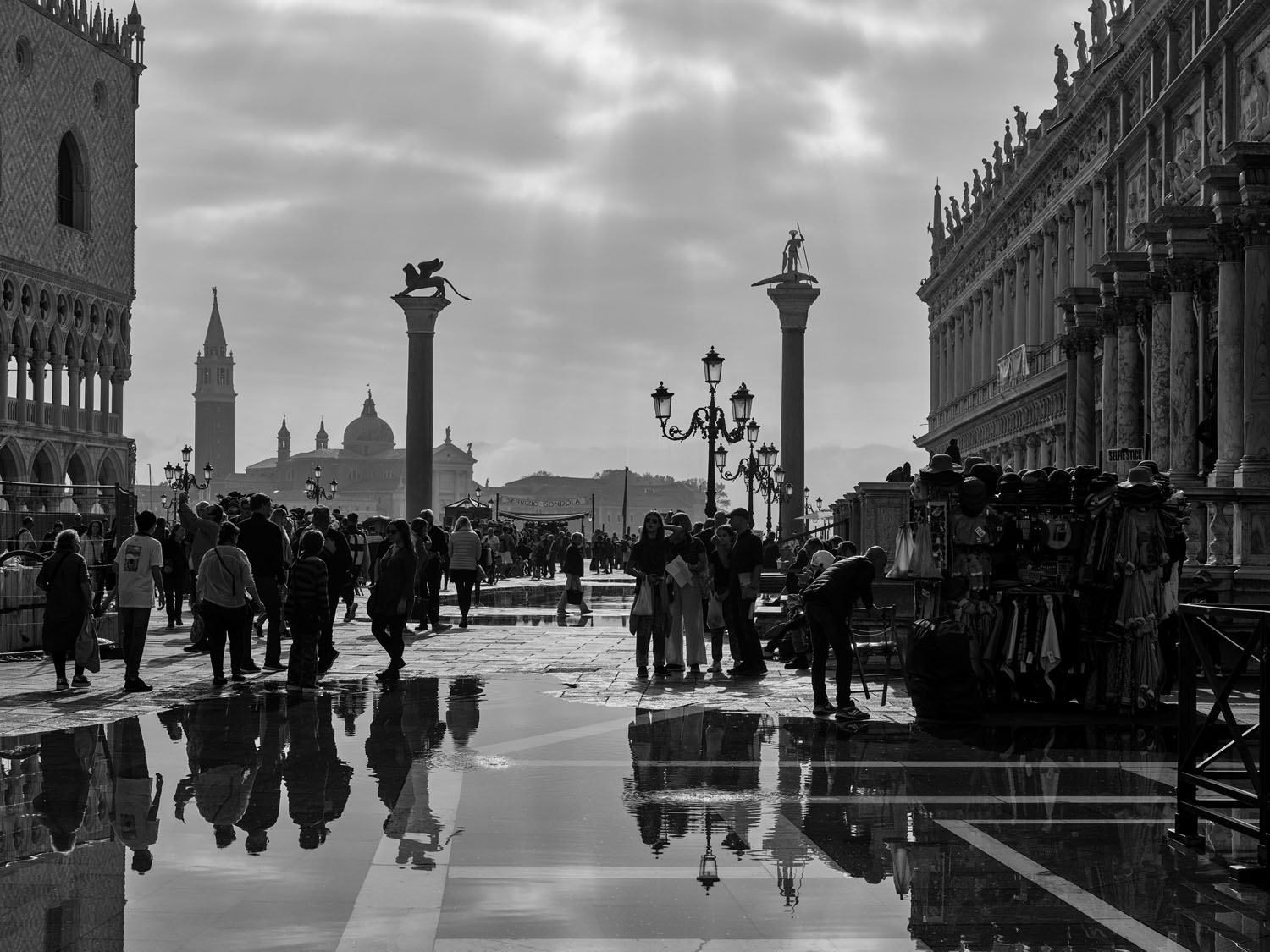
Venice – there is probably no other city with so many historical facades to offer as the lagoon city. From Canaletto to Turner and Monet, it provided an impressive backdrop for painting early on. Some reproduce it with each brushstroke true to color and contour in clear forms. Others romanticized it or gave free rein to the color frenzy of Impressionism. They were followed by the early photographers: Carlo Naya, Domenico Bresolin or Giuseppe Cimetta, Antonio Perini and others. With their large plate cameras (shooting sizes of 70 × 50 cm, for example) and the new developing methods, they were able to leave the studios and devote themselves to Venetian city scenes.
Back to the present: Venice has since been added to the UNESCO list of World Heritage Sites and, with its historic center, is a popular destination for excursions. While some stroll leisurely through the alleys or take part in the urban hustle and bustle by gondola, others look specifically for perspectives and angles. From a photographic point of view, autumn is certainly an interesting time to travel. The harsh light of summer gives way to the warm colors of autumn. With a bit of luck, the lagoon is shrouded in mist in the morning hours, which visibly dissipates in the still low sun. With the autumn also begins the Aqua Alta season, the piazza and the numerous campos and alleys are flooded in the rhythm of the tides through the manhole covers.
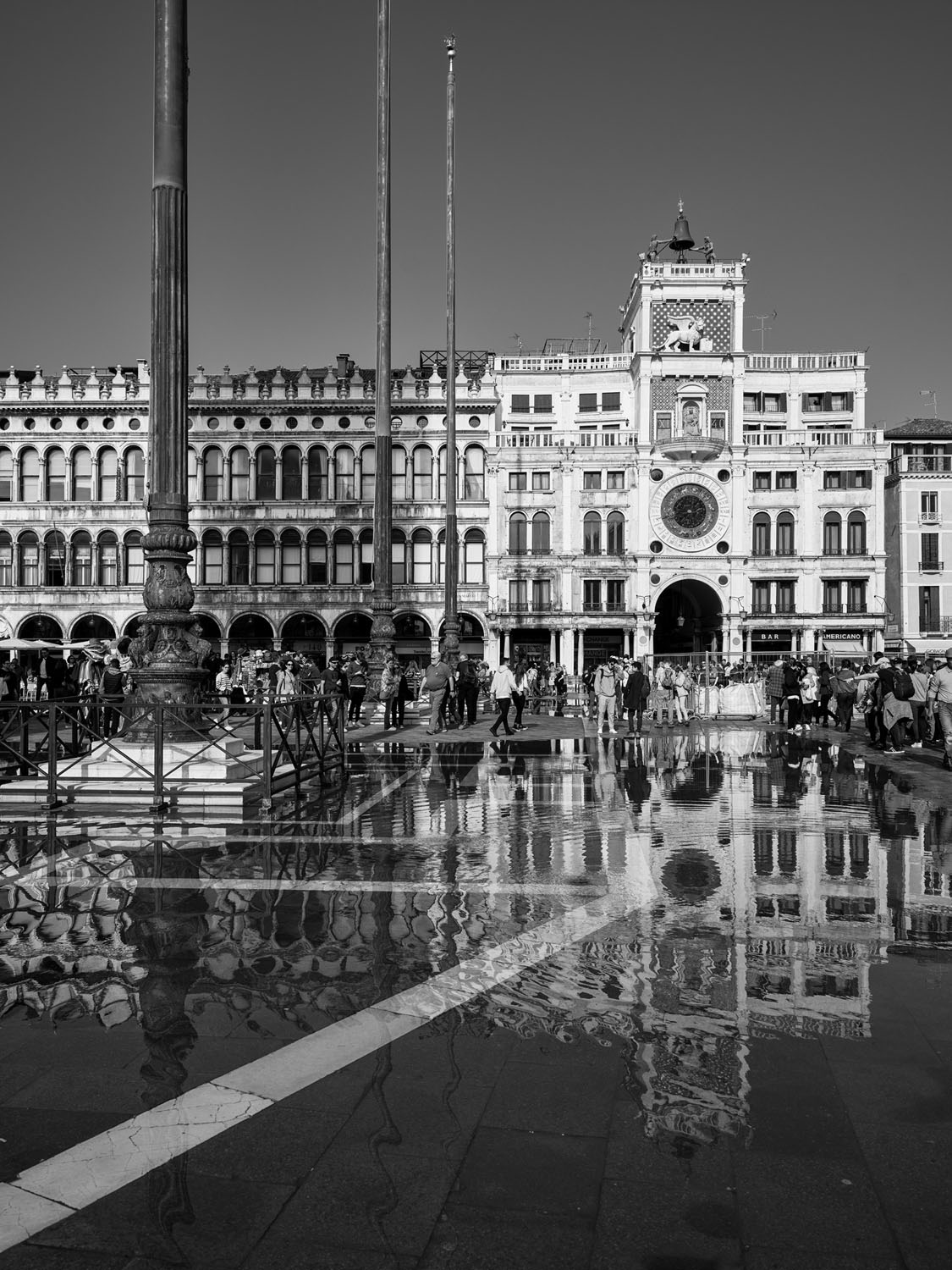
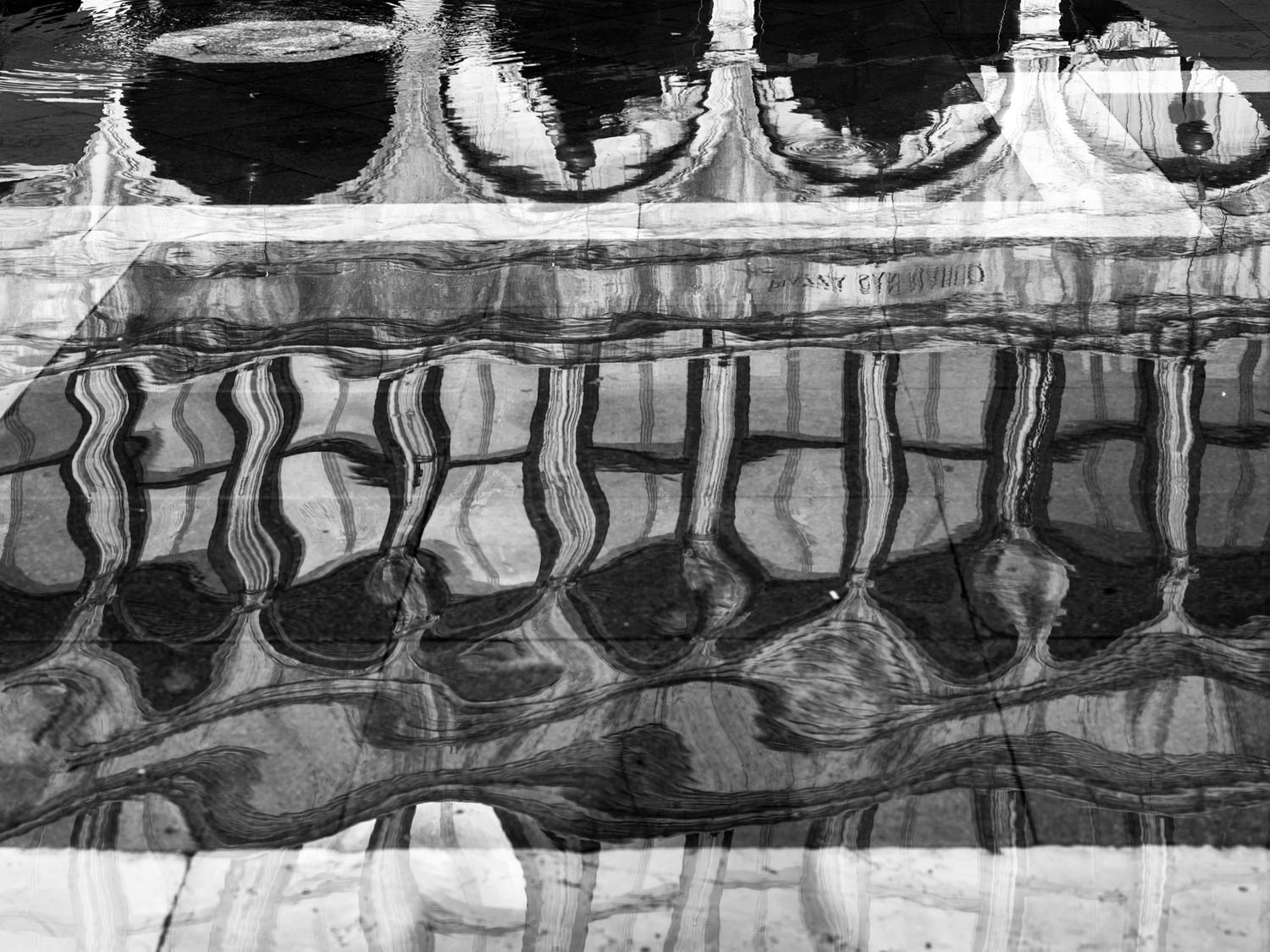
The heart of Venice is the Piazza San Marco with its imposing view of the richly decorated facade of the Basilica di San Marco and its mighty roof domes. It was built in the 9th century of our era as the palace chapel of the Doge’s Palace. The facades of the Procuratie Vecchie with its arcades also provide an impressive backdrop. It once housed the Venetian building authority, located in the Middle Ages; as well as the clock tower on the north side and the Campanile on the south side of the square. Between the Campanile and the Basilica, the path leads from the Piazza across to the Doge’s Palace on the Piazzetta and onto the Grand Canal.
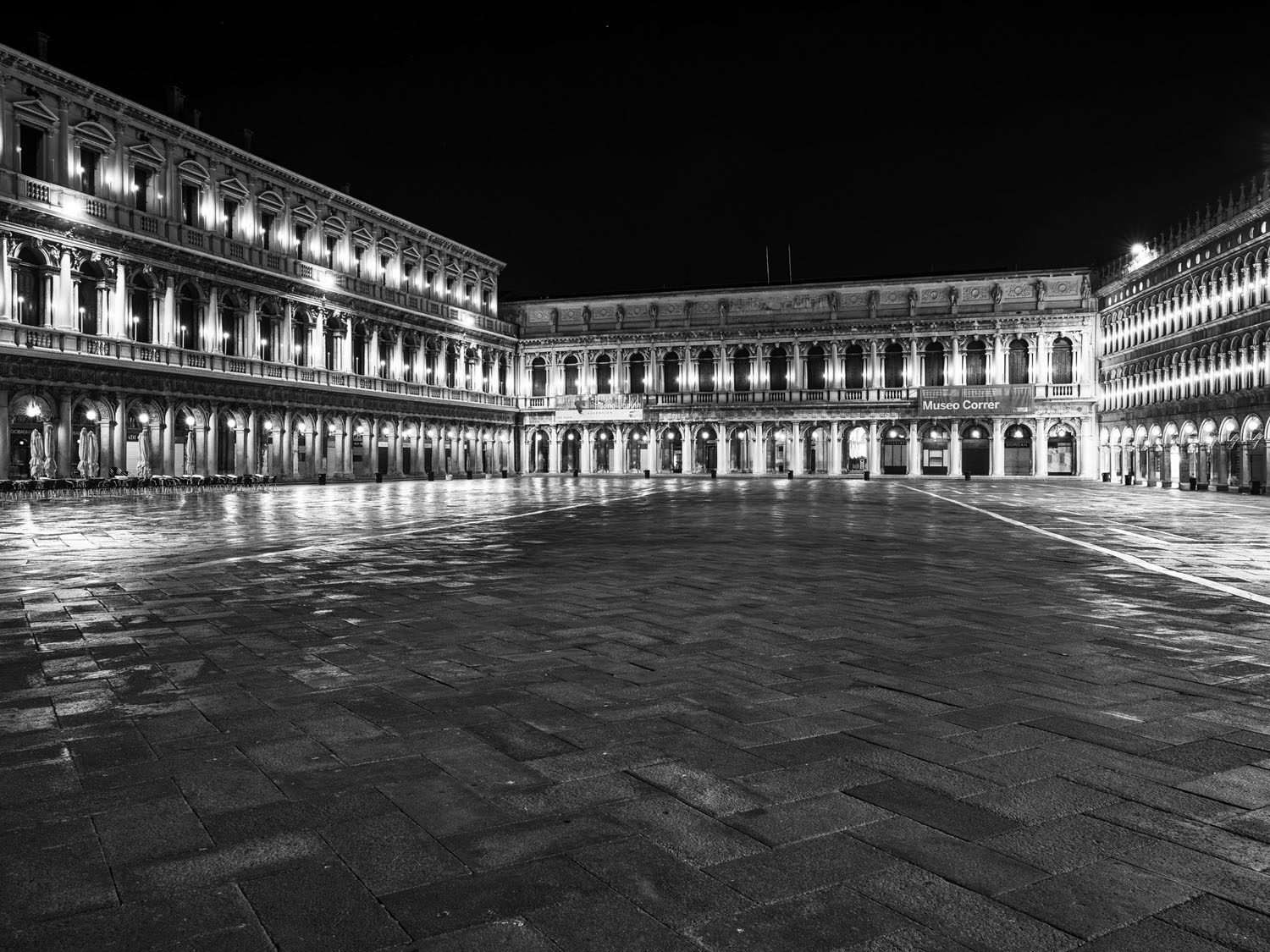
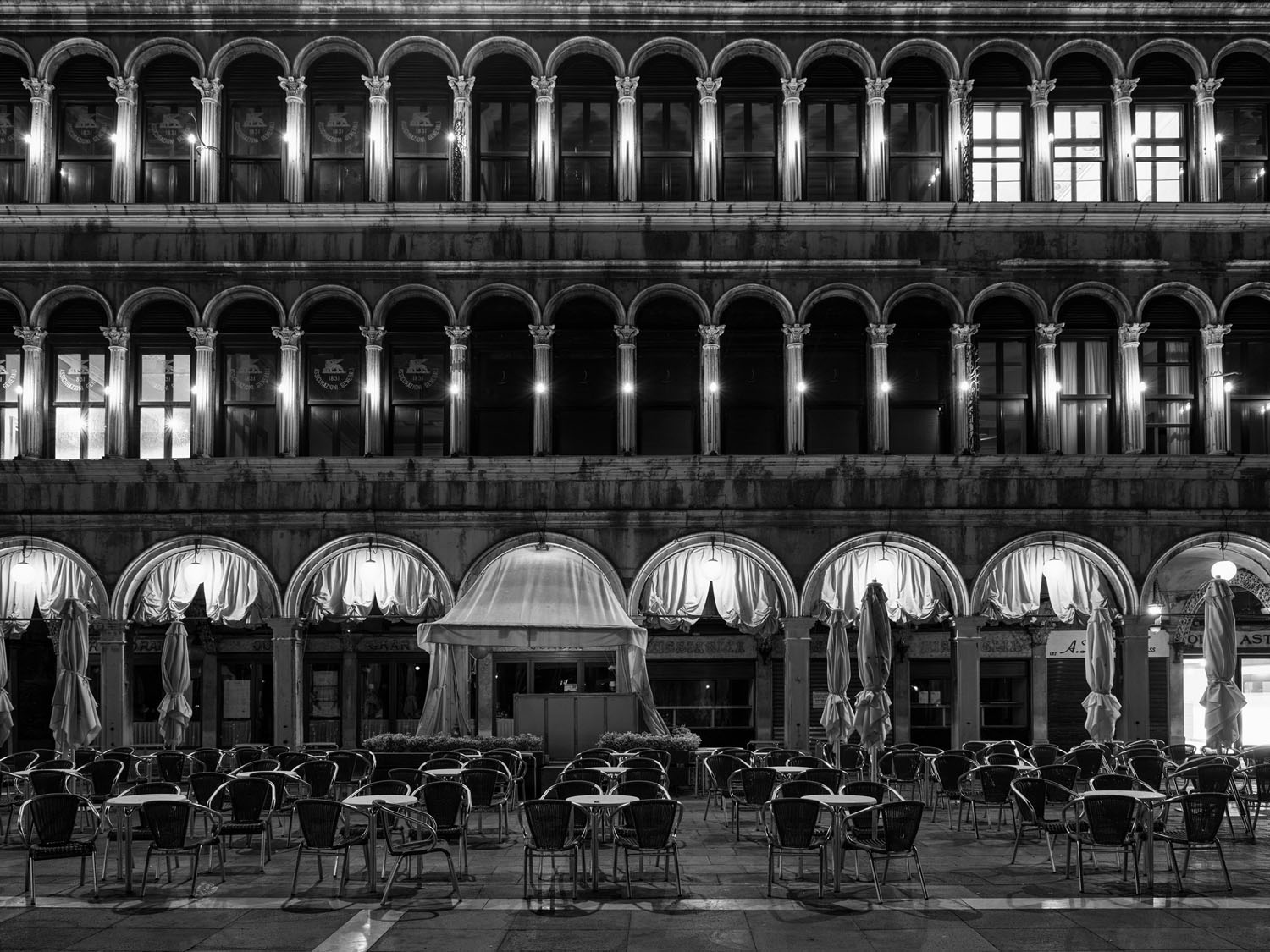
RIGHT: Fuji GFX 100 . Fuji GF32-64mmF4 @32mm . f/8 . 1″ . ISO 320 . WB 2.820K . Tripod . corrected in perspective . Film simulation ACROS (Red) – Well before sunrise in Piazza S. Marco | San Marco
At the Piazzetta join the gondolas gently bobbing in the waves of the lagoon with a view of the Chiesa di San Giorgio Maggiore. A little further to the left of the Ponte della Paglia, the view extends to the Ponte dei Sospiri, known as the Bridge of Sighs. A little further to the right on the Piazzetta, in the direction of the San Marco Giardinetti dock, the view opens onto the Basilica di Santa Maria della Salute. All motifs are considered “hot spots” or “must have” from a photographic point of view. Even if they have been literally photographed to death in the meantime, they should not be missing in the course of a photographically ambitious approach to this city.
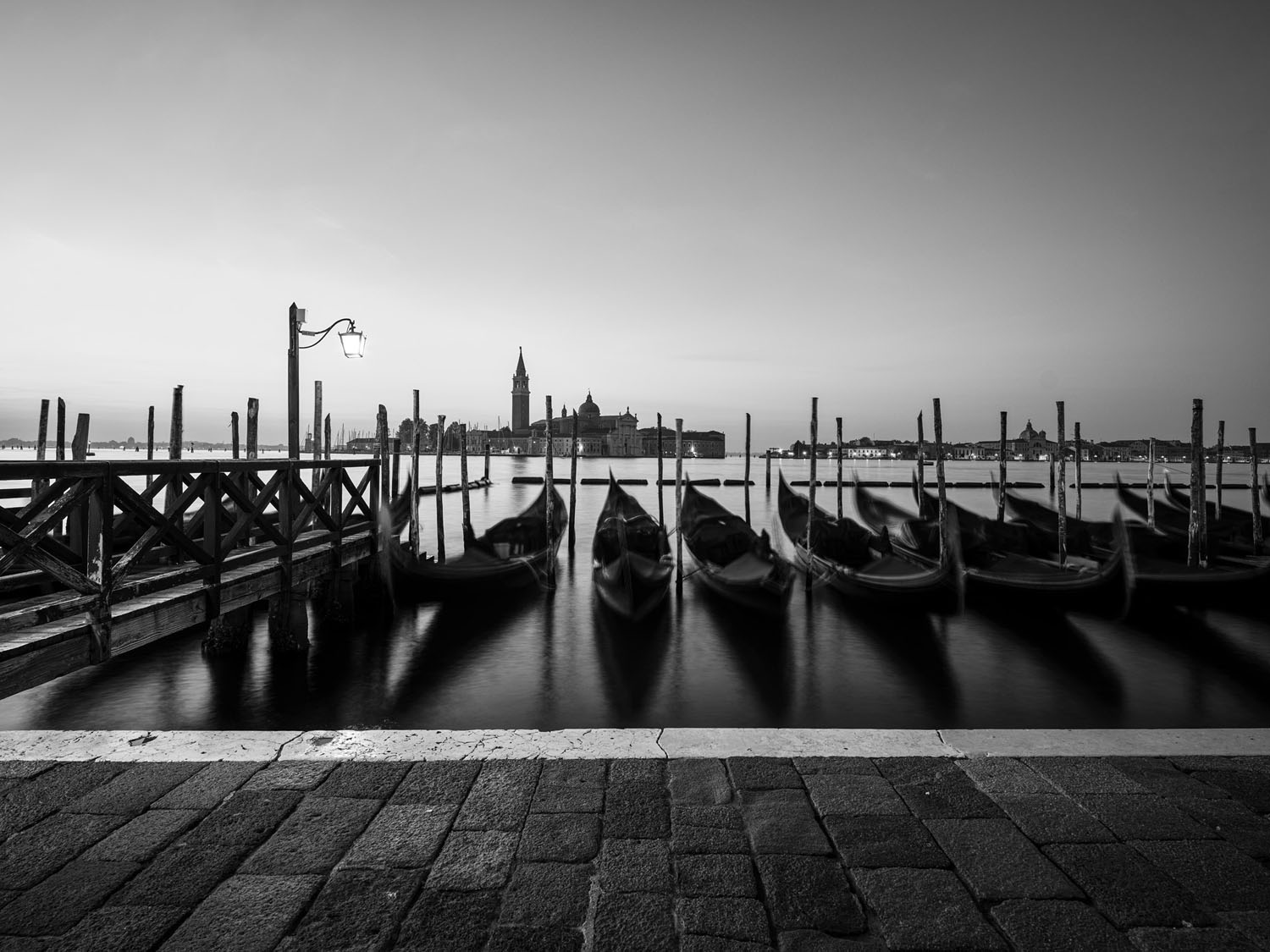
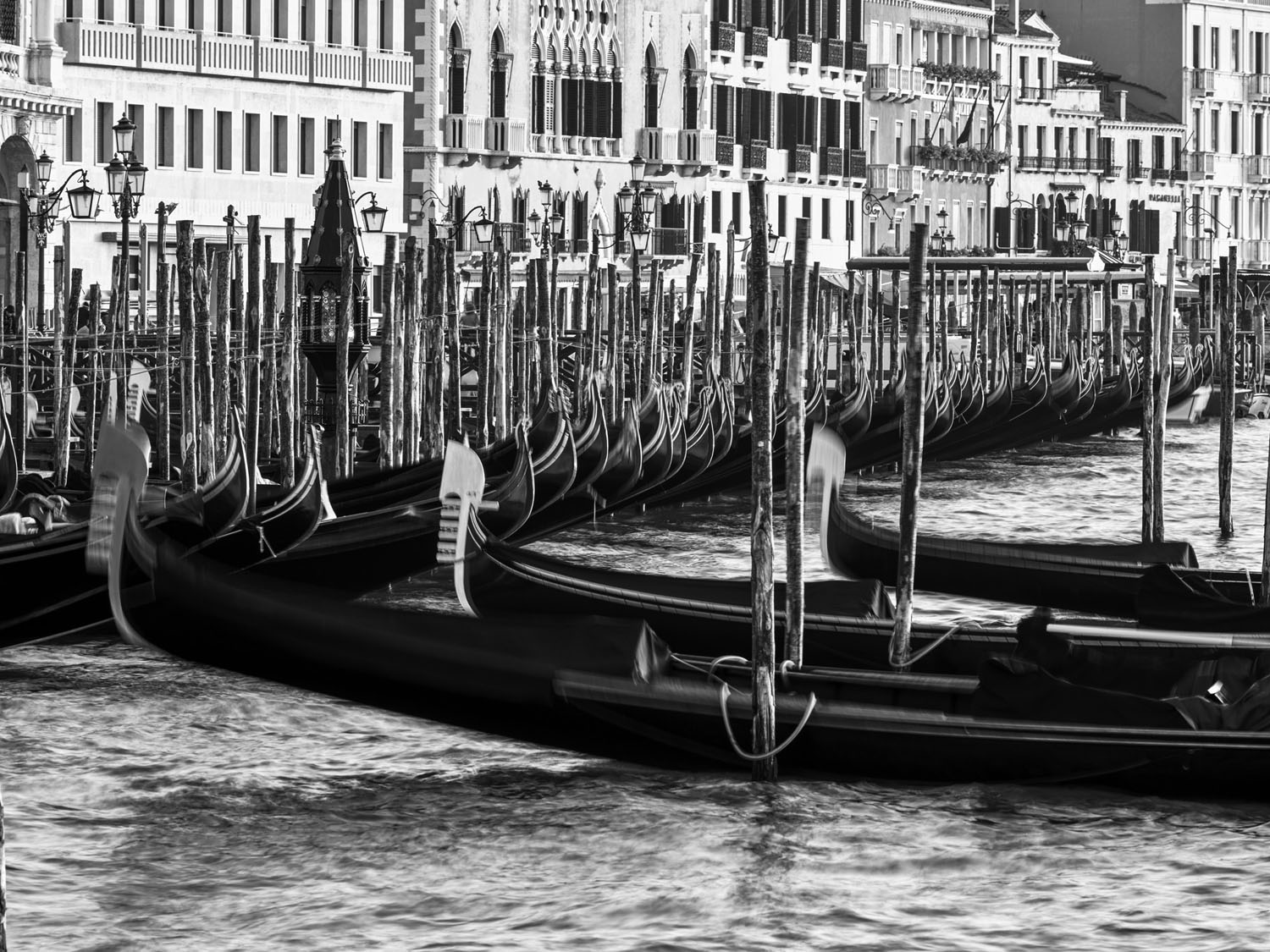
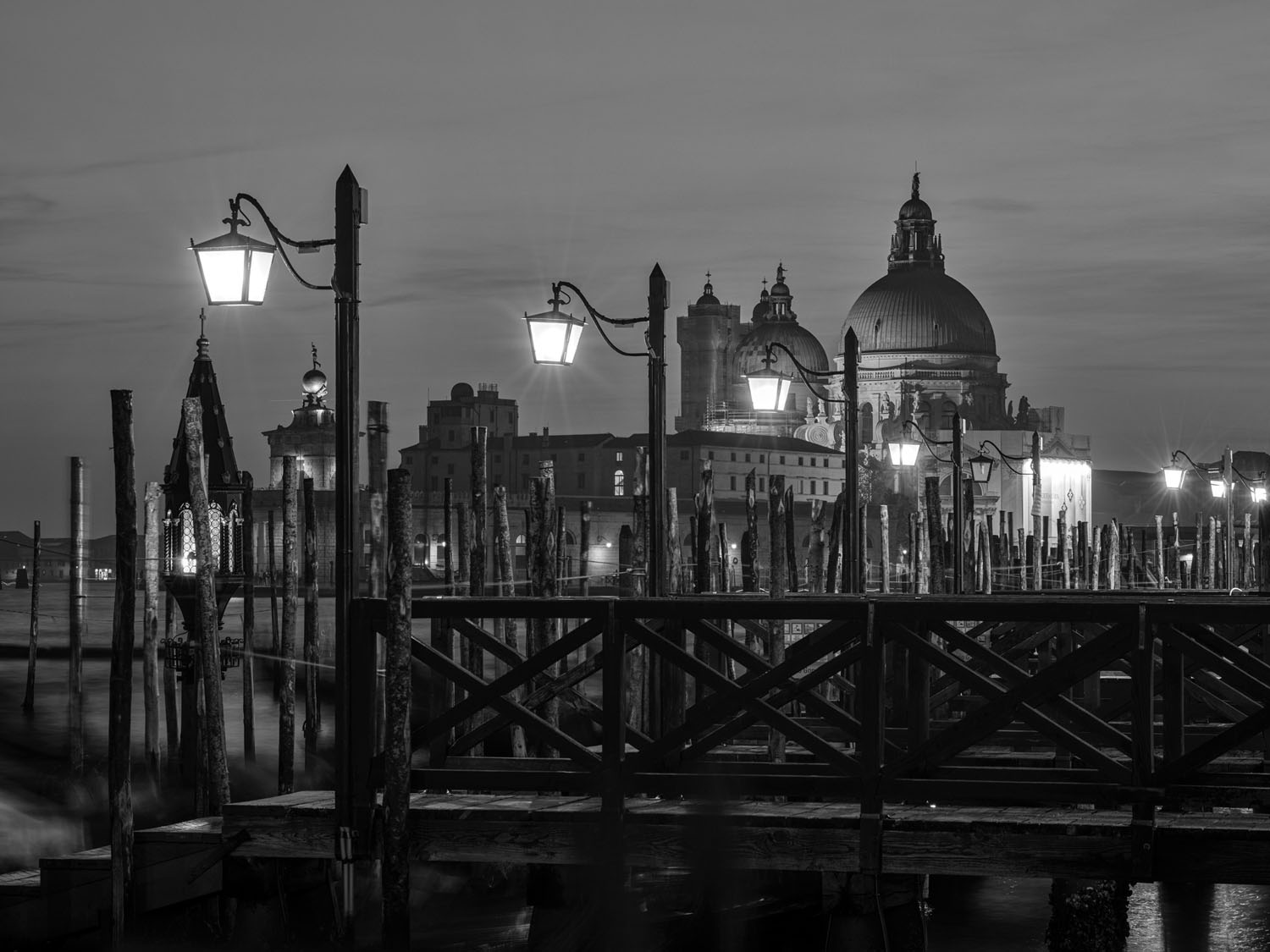
RIGHT: Fuji GFX 100 . Fuji GF100-200mmF5.6 @105 mm . f/16 . 15″ . ISO 100 . WB 5.400K . Filter: CPL + ND 0.9 . Tripod . Film simulation ACROS (Red) – In the morning at the Piazzetta S. Marco | San Marco
One of the many photographic challenges are the crowds that move with me through the alleys and across the squares. To avoid these, I often start two hours before sunrise, especially when heading to Piazza San Marco and the adjacent Piazzetta. Occasionally, I also set out after dinner. During the week, the alleys and squares are also almost deserted after 11:00 pm.
During the day I roam the sometimes narrow, winding streets, I do without my tripod for reasons of space, in this organic turmoil. I then exchange my photo backpack for a slim photo bag including a water bottle, which I hang around my side. Even though I use a weekly pass for vaporettos between my spots, the HealthCare app on my phone shows me a daily tally of 15,000 to 23,000 steps. Kudos to the technology or advancement of cameras: how light and handy – powerful today’s camera systems make for comfortable photography, compared to the historic city photography of the late 19th century.
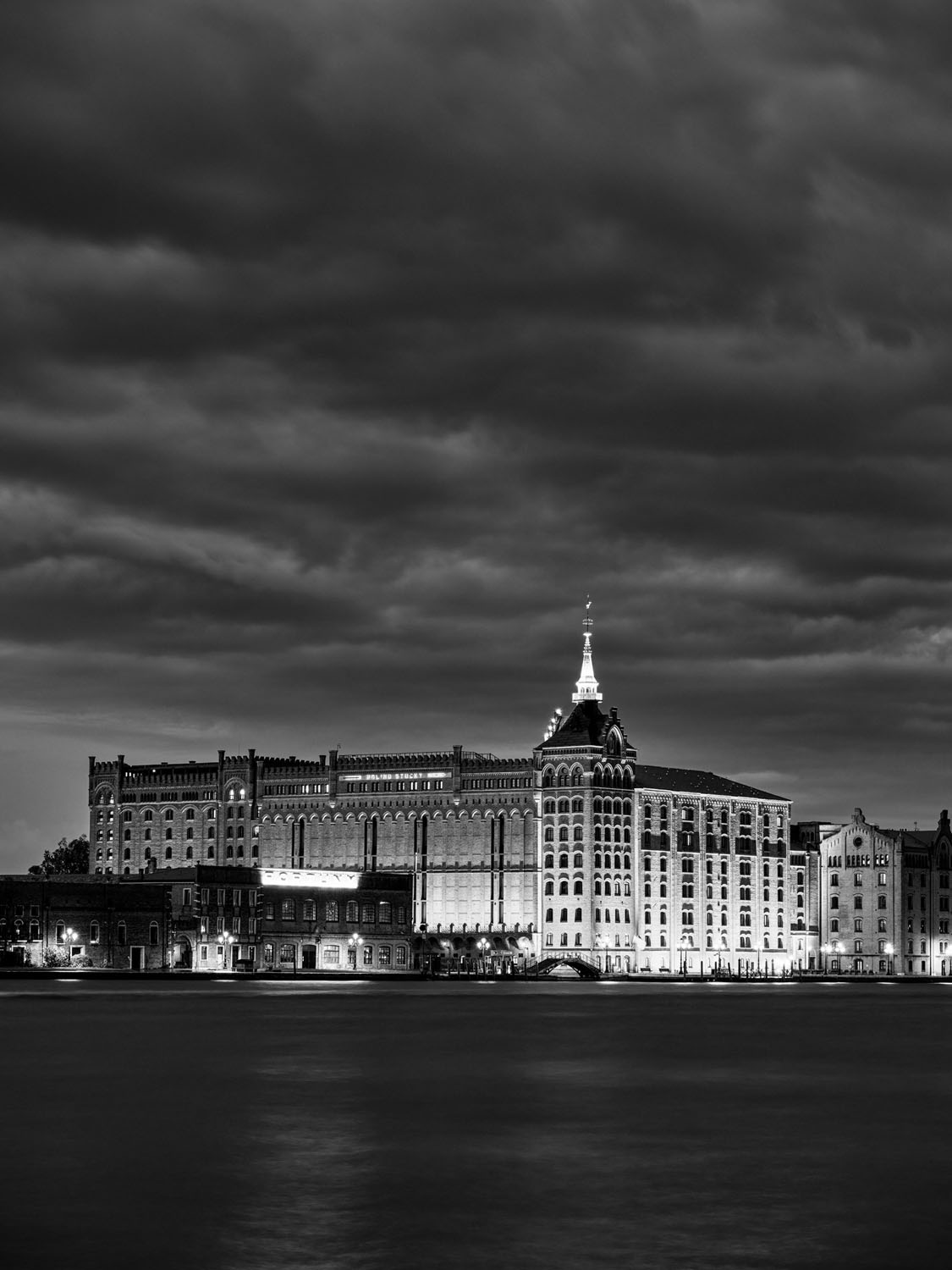
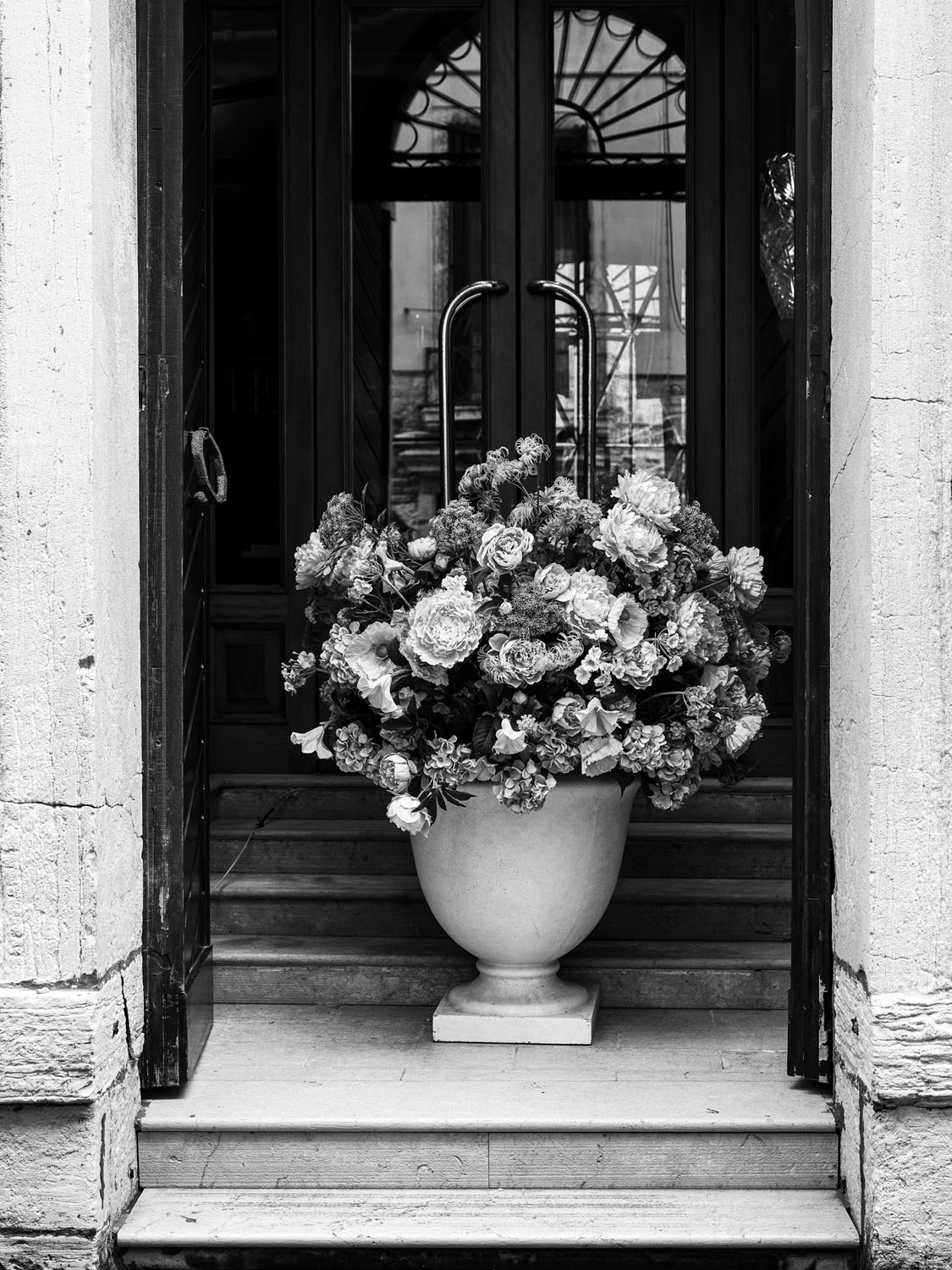
RIGHT: Fuji GFX 100 . Fuji GF32-64mmF4 @61mm . f/5.6 . 1/100″ . ISO 640 . WB 4.460K . Film simulation ACROS (Red) – Hotel Ca’ dei Conti am Rio de S. Zanirovo | Castello
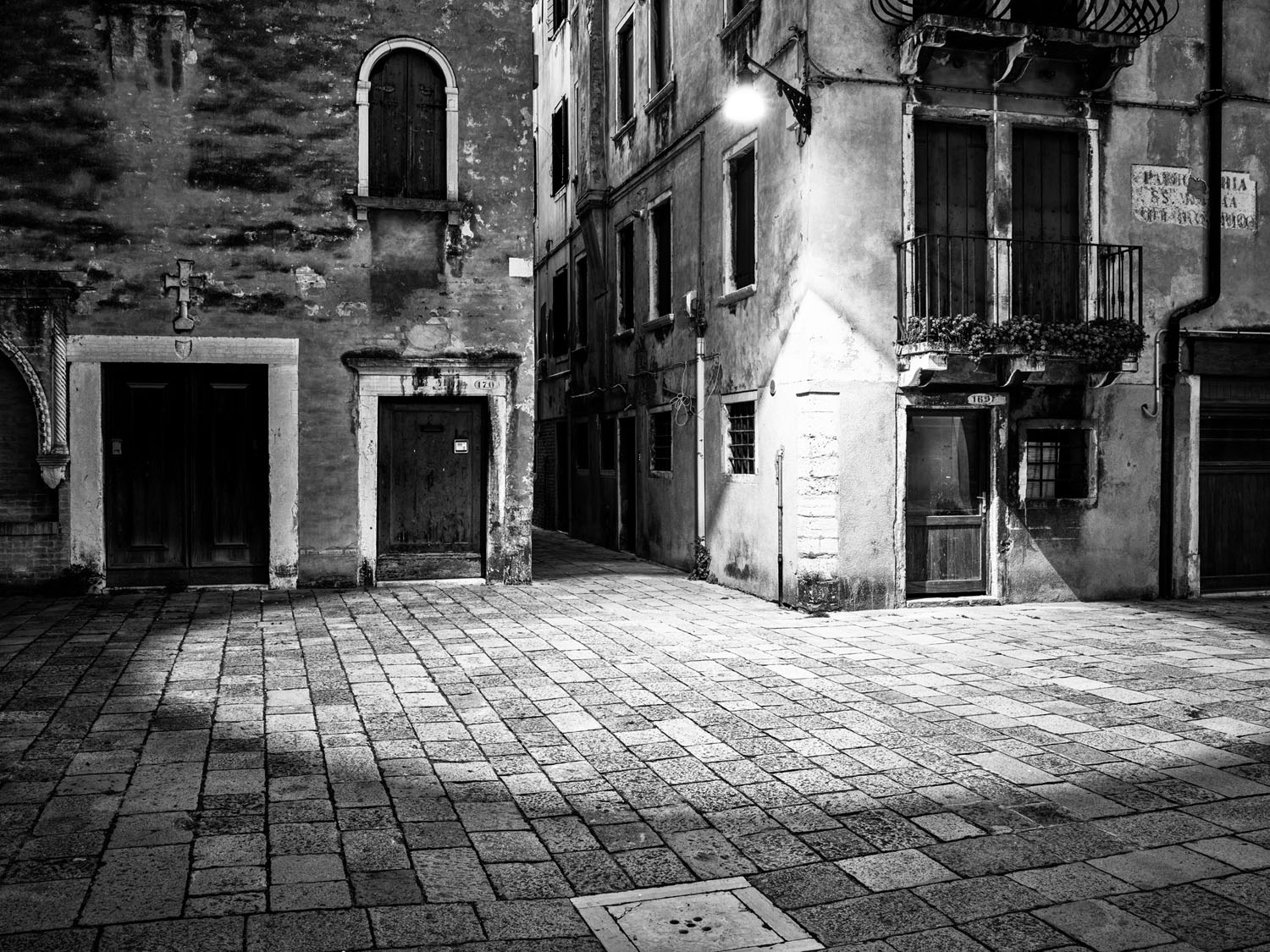
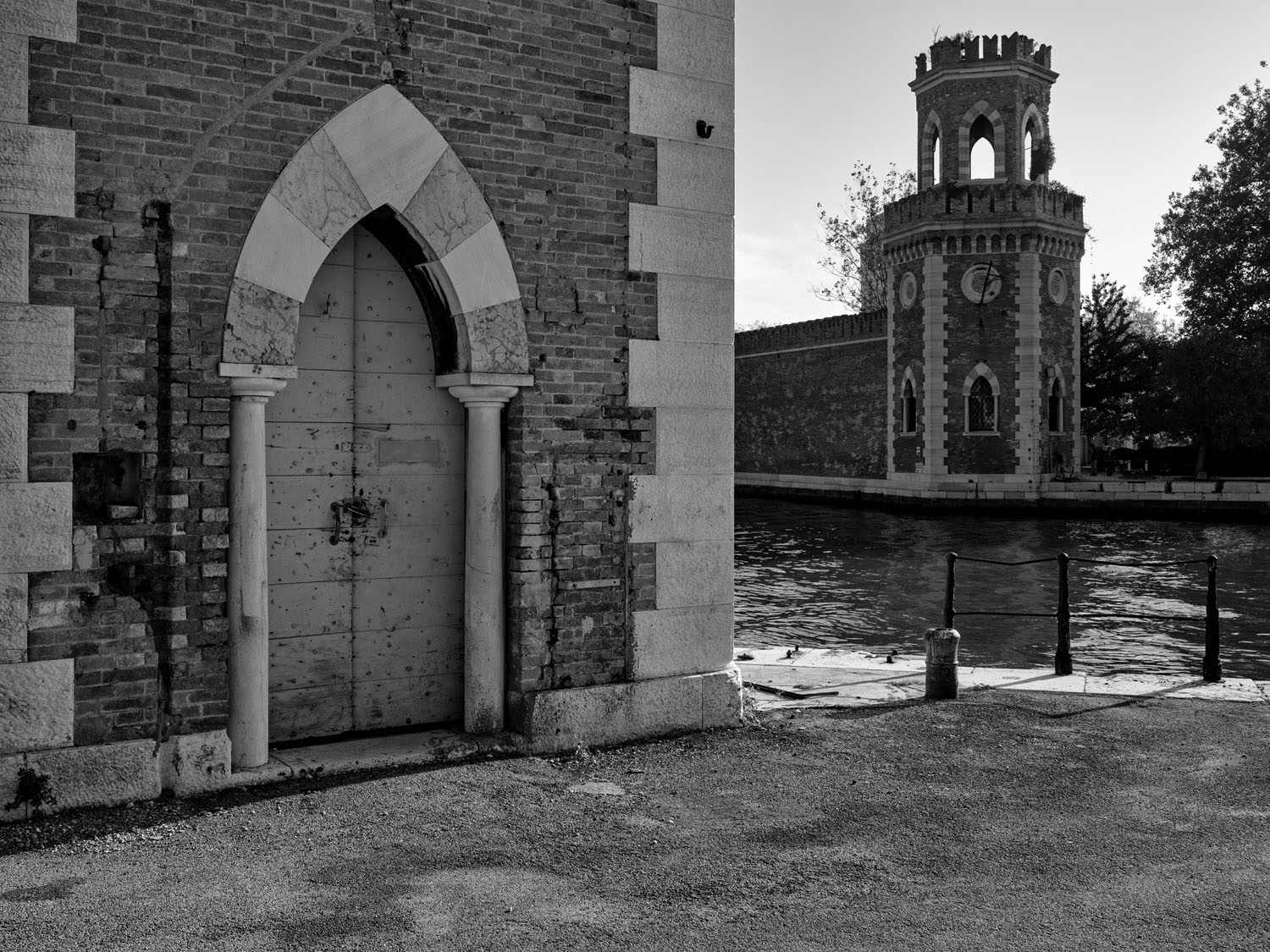
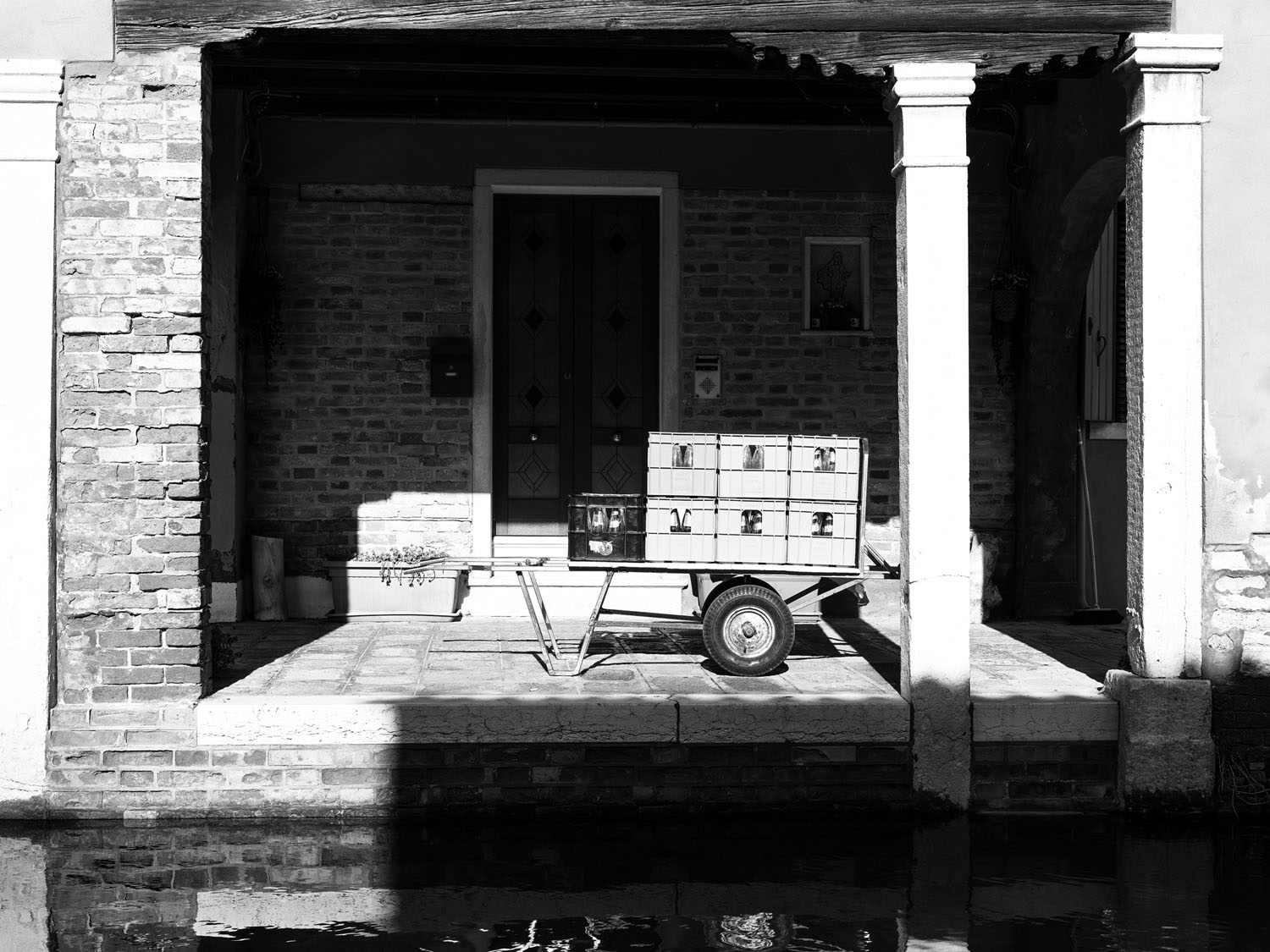
RIGHT: Fuji GFX 100 . Fuji GF32-64mmF4 @55mm . f/9 . 1/640″ . ISO 320 . WB 4.560K . Film simulation ACROSS (Red) – …Lieferservice auf dem | Fondamenta di Terranova | Burano
How do I now get the idea to depict such a dream scenery with black and white developments? It is the attempt to counter the loud, shrill – oversaturated hustle and bustle. A conscious reduction to clear forms supported by a light-dark contrast.
When color films became increasingly established in the seventies of the last century, it was necessary to rethink image design. In addition to the previous design elements such as dots, lines, areas and shapes, the ‘then’ new element of color with its contrasts was now to be integrated into the image design. Today it is exactly the other way around: In our time the challenge lies in the conscious renunciation of color as a design element!
In earlier years, with the SLR camera, I took later B/W developments without exception with the picture style or Picture Control (Nikon) ‘Standard’, i.e. in color. The B/W conversion took place only afterwards in the digital darkroom. I preferred to use Silver Efex from the DxO NIK Collection. I used the setting ‘Monochrome’ in the picture style most likely to be able to concentrate better on the image composition before taking the picture.
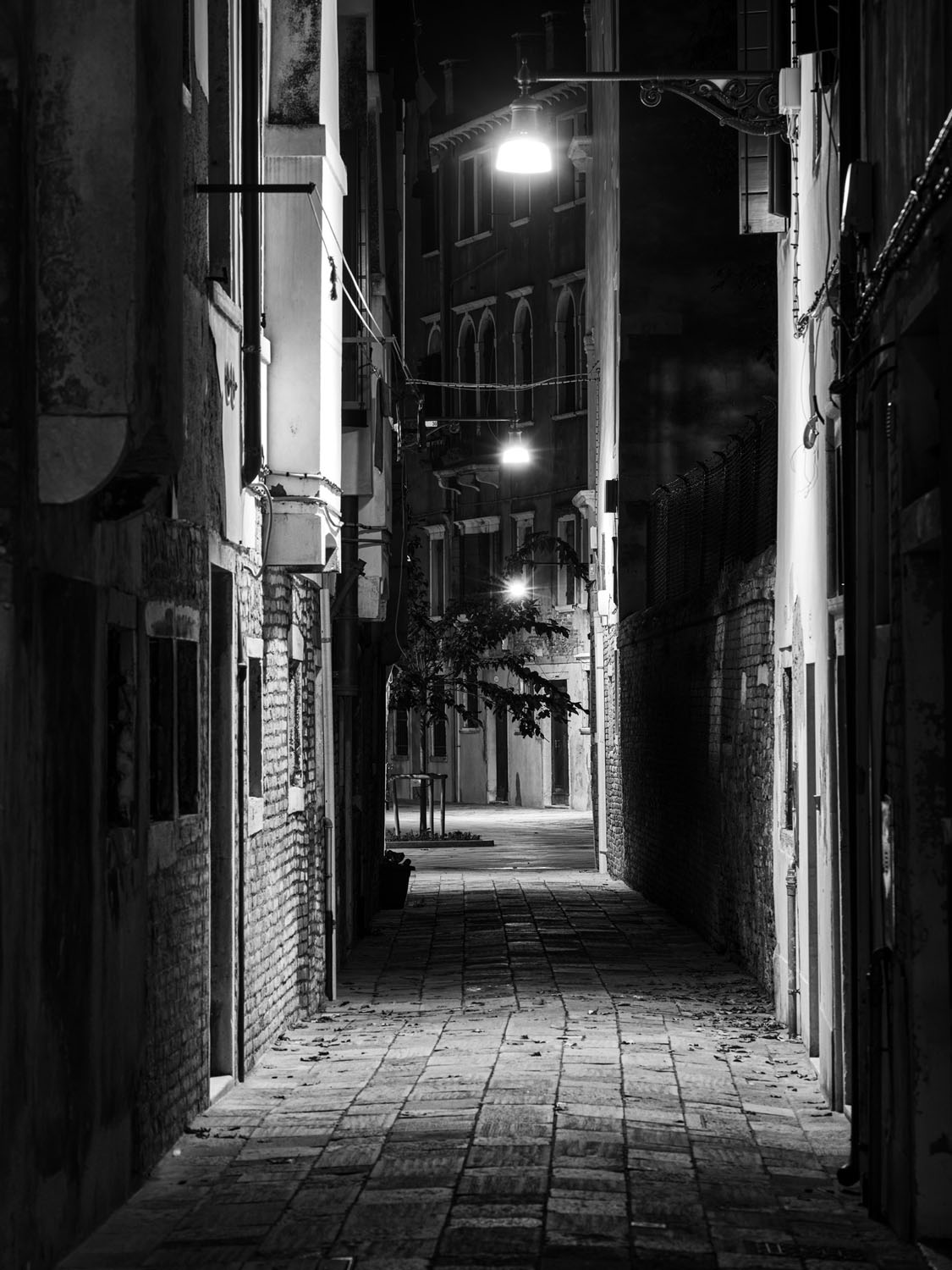
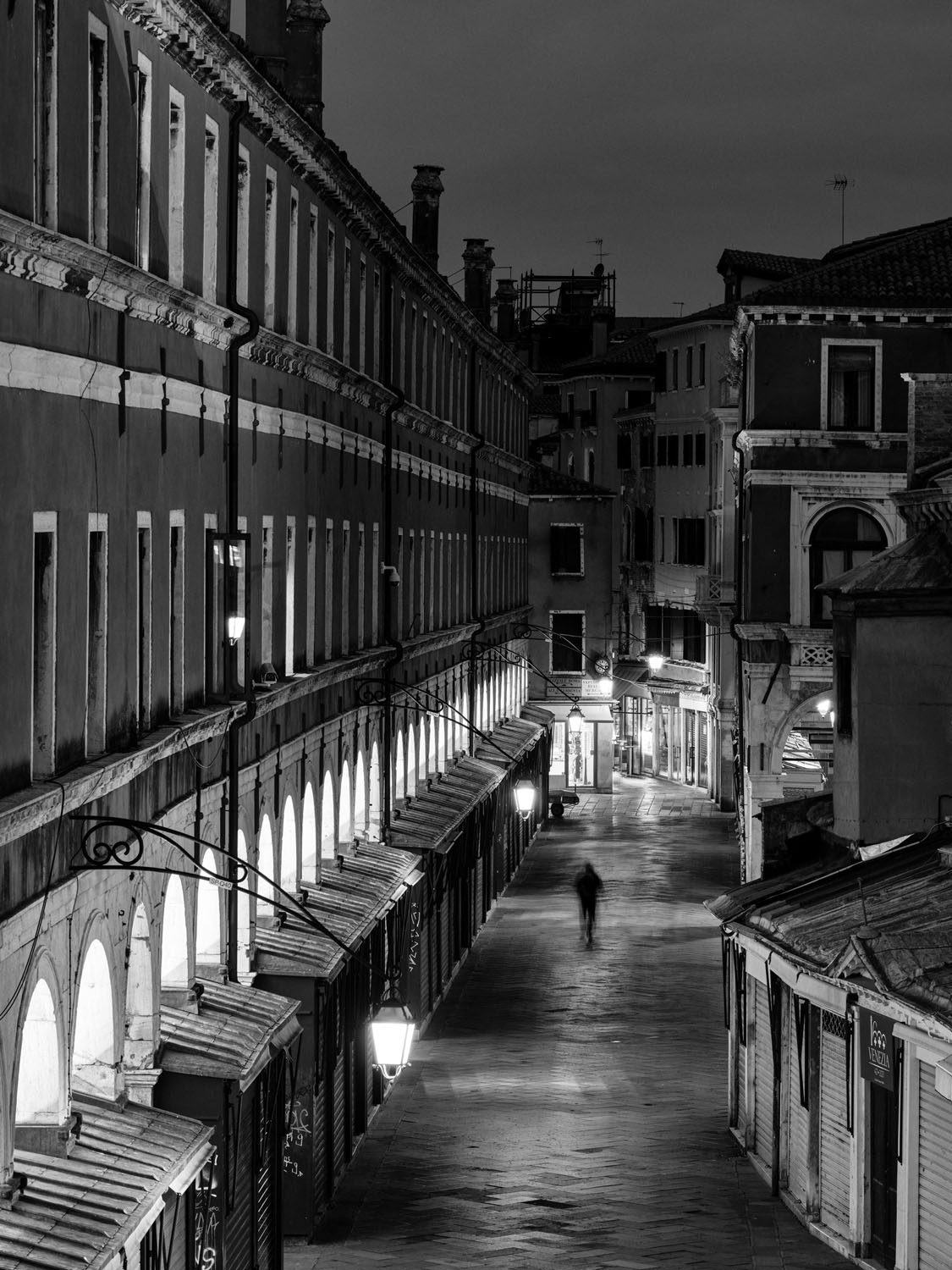
RIGHT: Fuji GFX 100 . Fuji GF100-200mmF5.6 @145mm . f/14 . 3″ . ISO 640 . WB 3.060K . Tripod . Film simulation ACROS (Red) – View with the dawn into the Ruga dei Oresi from the Ponte di Rialto | San Polo
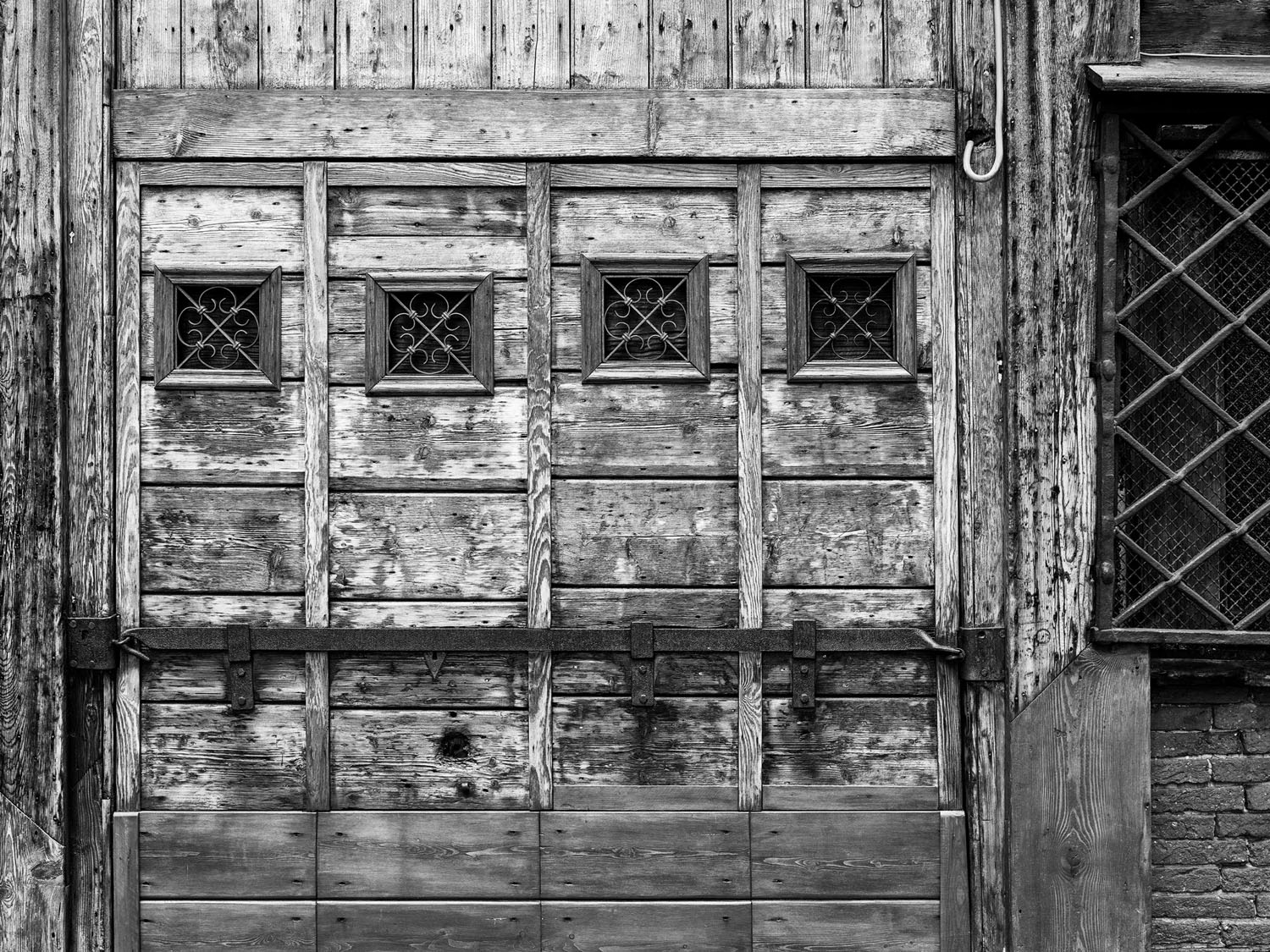
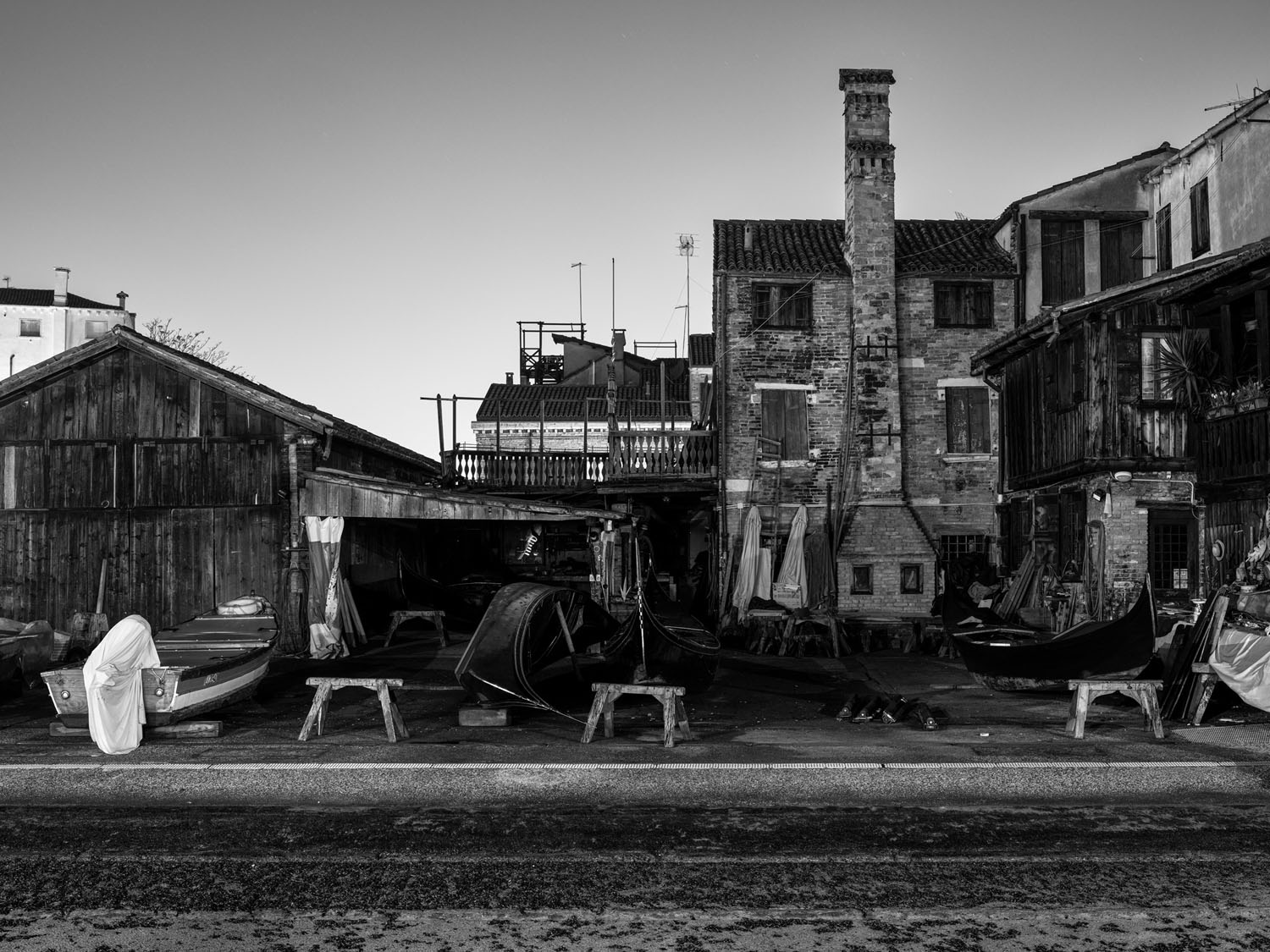
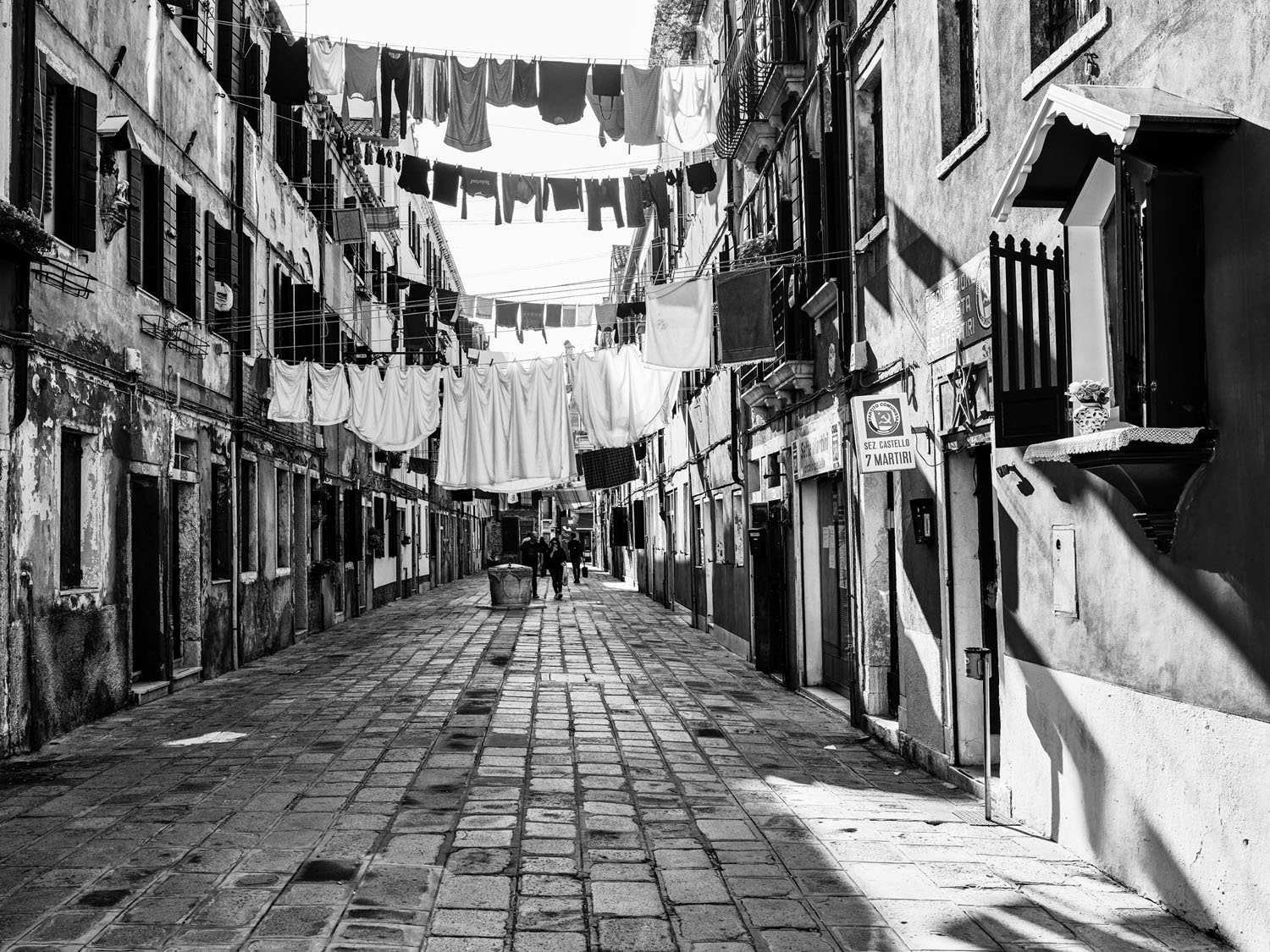
RIGHT: Fuji GFX 100 . Fuji GF45-100mmF4 @46mm . f/7.1 . 1/250″ . ISO 320 . WB 4.370K . Film simulation ACROS (Red) – Washing day in the Calle Nuova | Castello
With the change to a Fuji system, this has changed in the sense that I am increasingly experimenting with the film simulations, the Fuji variant of the picture style or Picture Control. Whereby, for better understanding, these are not the classic presets like Brilliant, Monochrome, Landscape, or Portrait, etc. Fuji has stored a series of presets here, which connect to the former contrast and color character of their analog film material.
The film simulation ACROS, for example, has been added. In addition to the standard setting, a digital variant of the contrast filter (optionally in standard, red, yellow and green) can be added or selected depending on the light or color situation. Hardly surprising that optical contrast filters were considered indispensable in analog B/W photography!

On my forays away from San Marco, I discover details and trivialities on San Polo, Dorsoduro, Castello and other islands that tend to go unseen or are only glimpsed in the hustle and bustle of everyday life. If I concentrate primarily on discovering and shaping the image detail, I fluctuate on location between an automatic white balance and the WB presets ‘daylight’ and ‘cloudy’ depending on the lighting conditions. The downstream image development that awaits me at home is reduced to adjusting the depths and highlights and occasionally fine-tuning the contrasts with the film simulation ACROS of my Fuji system. Something else I should notice when I review the images later: contrary to my preference for landscape, I shot a surprising amount in portrait format during the course of this visit to the city. However, I attribute this change in my photography more to a sensitization of my perception than to my B/W attempt.
On the last evening of my tour, I also pass the Ponte dell’Accademia on my way back to the hotel. To my surprise, I come across a lively crowd of people in the middle of the bridge at half past midnight. My last image idea for this trip turns out to be unfeasible in no time, because the bridge cushions the movements of the group, which inevitably leads to blurring in long exposures. As it turns out, it’s a French student group dedicated to painting. Under the guidance of their professor, they are practicing depicting the light reflections that the lanterns on the Grand Canal leave behind in great numbers. Fascinating how such detailed sketches are created there with just a few hand strokes.
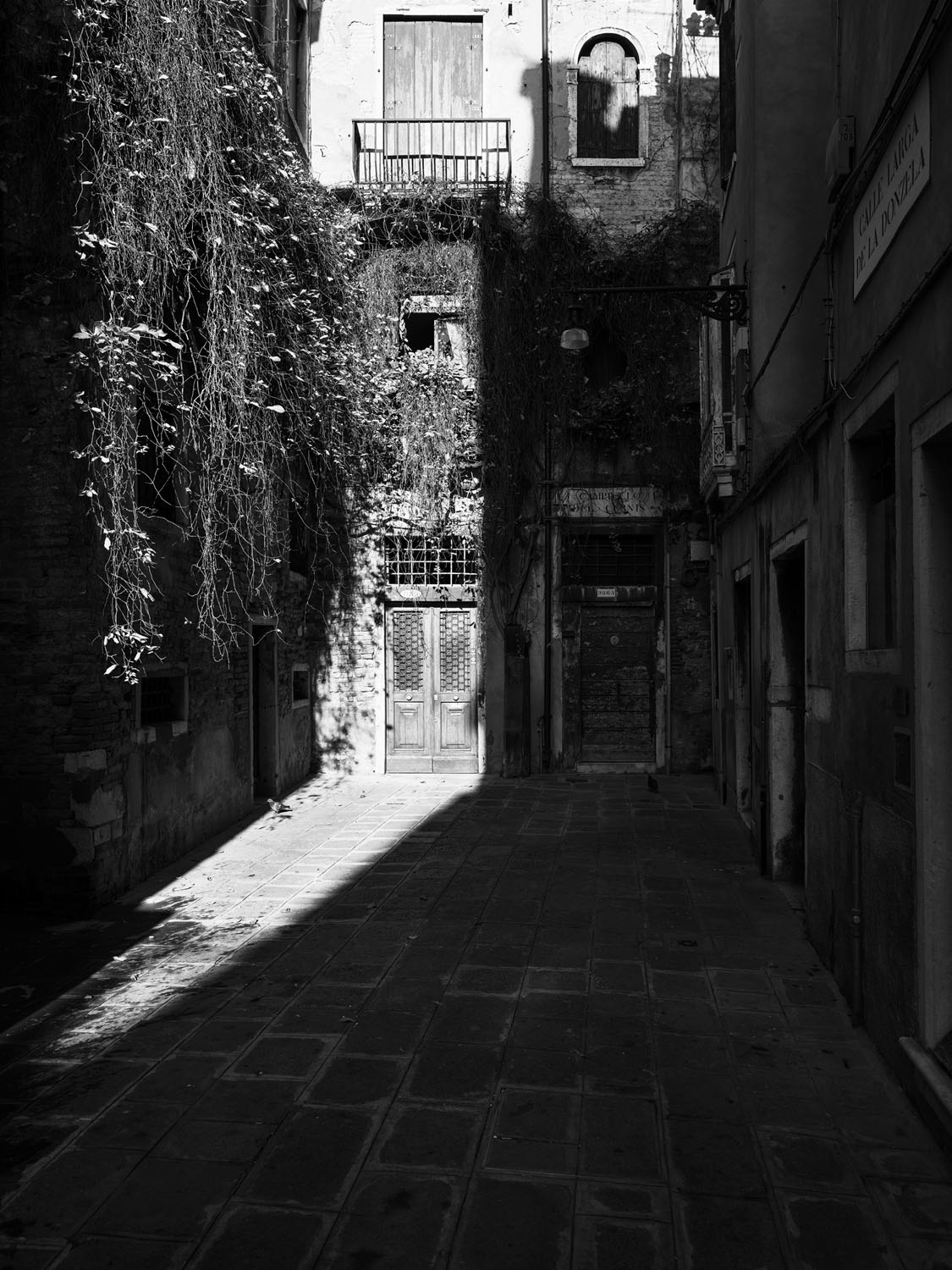
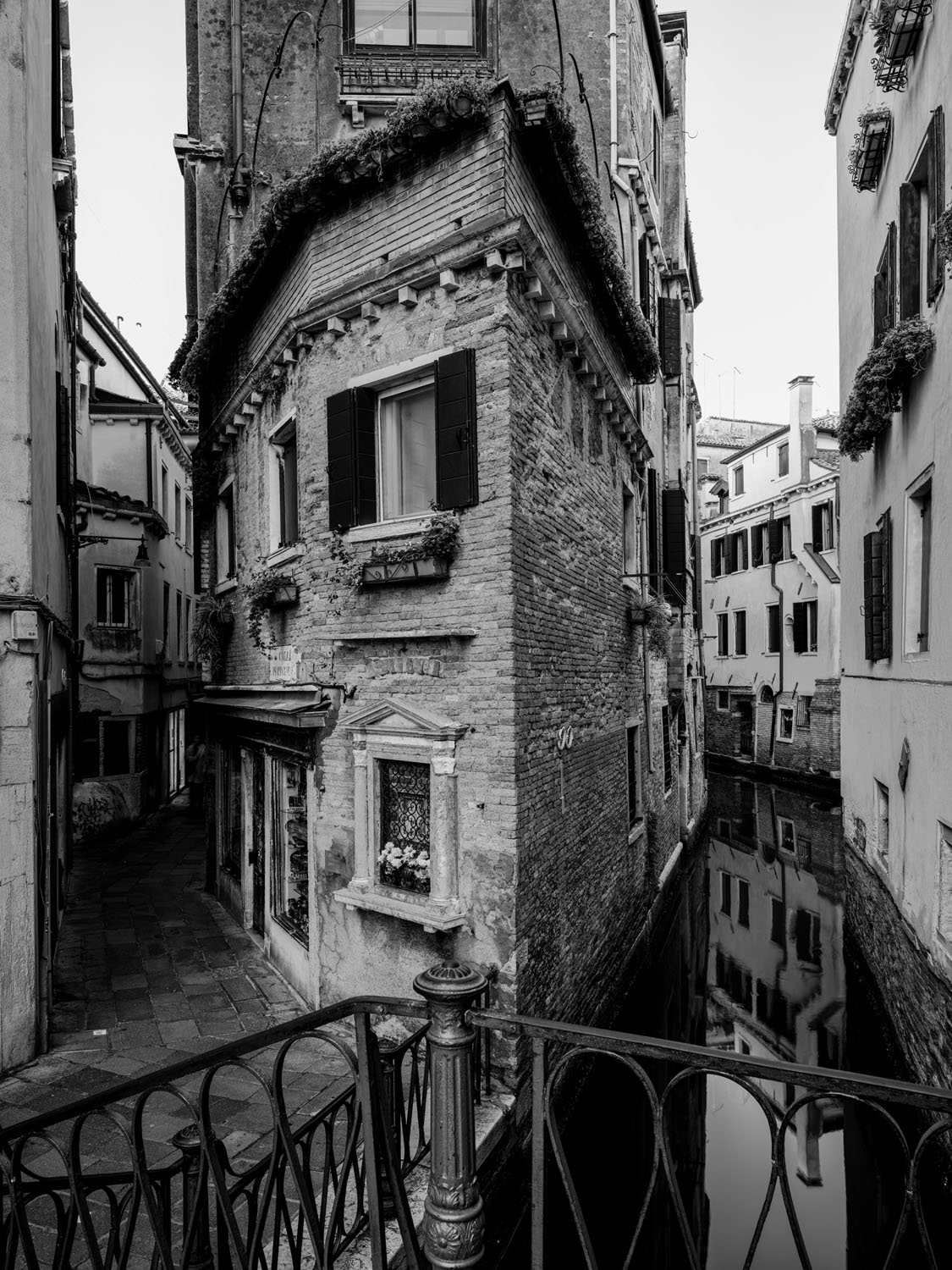
RIGHT: Fuji GFX 100 . Fuji GF20-35mmF4 @30mm . f/11 . 1/20″ . ISO 160 . WB 4.800K . Tripod . two row vertical panorama . Film simulation ACROS (Red) – Ponte dei Carmini | Castello
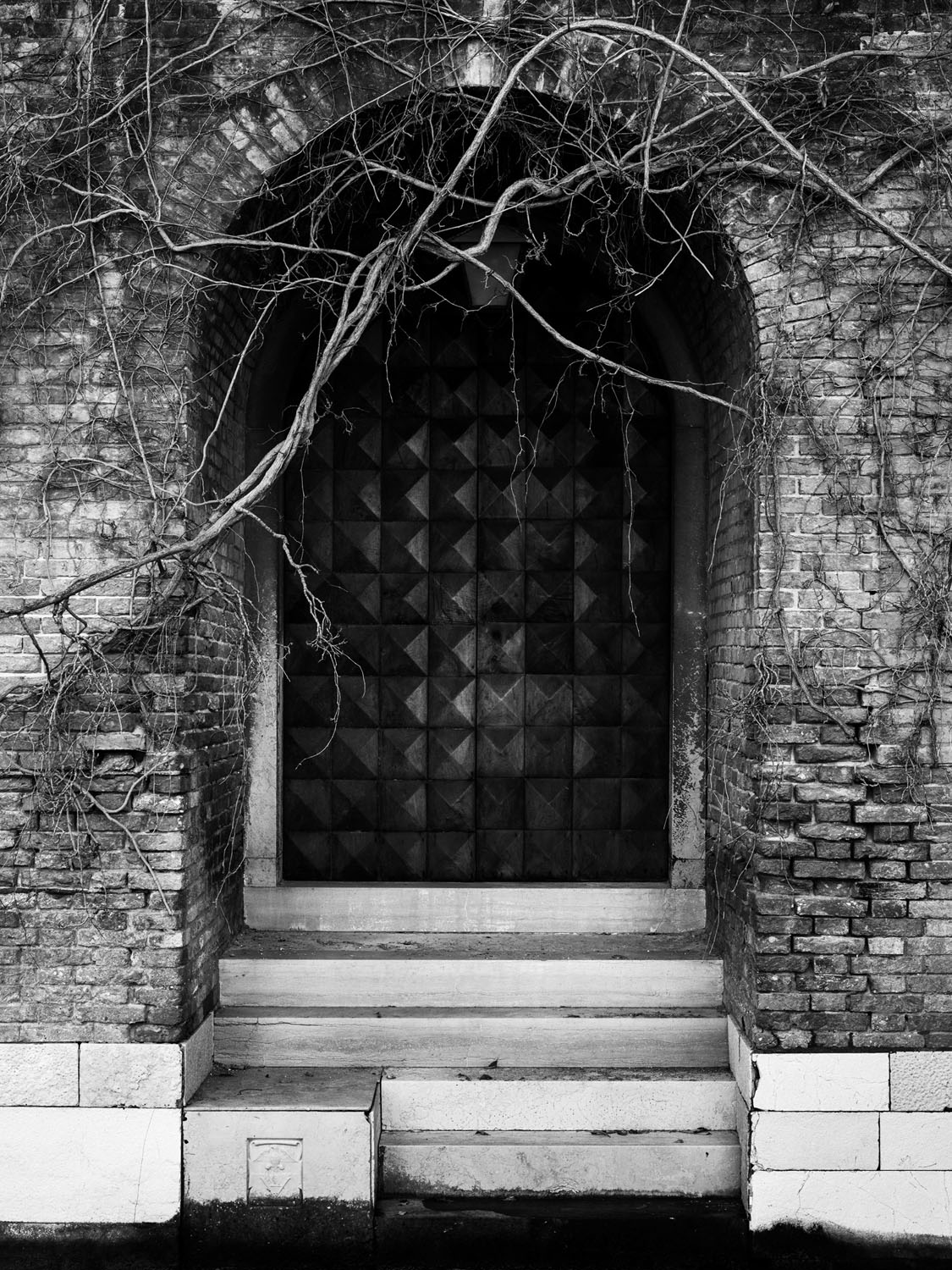
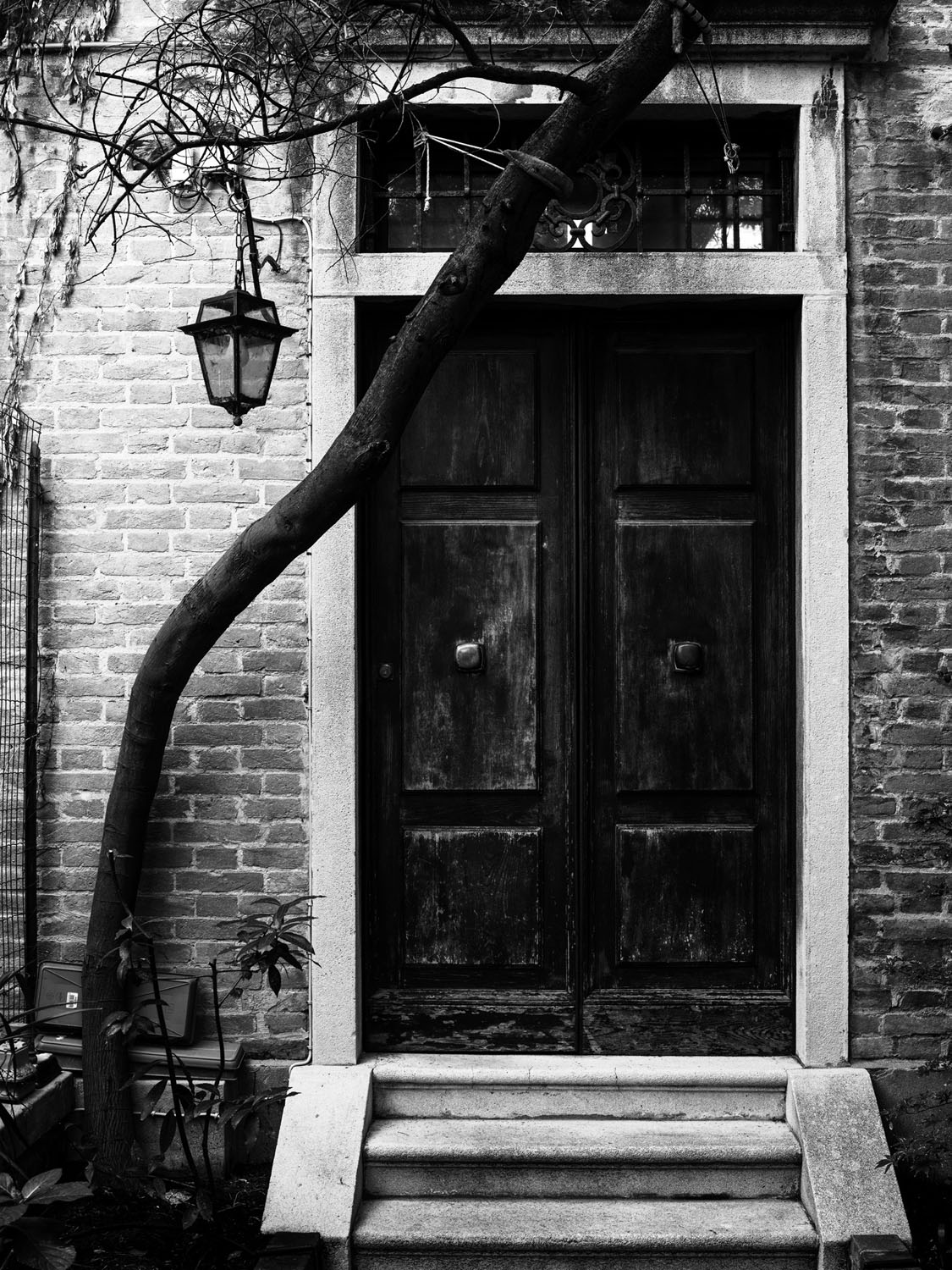
RIGHT: Fuji GFX 100 . Fuji GF45-100mmF4 @55mm . f/11 . 1/20″ . ISO 640 . WB 4.350K . Film simulation ACROS (Red) – Fondamenta Toletta | Dorsoduro
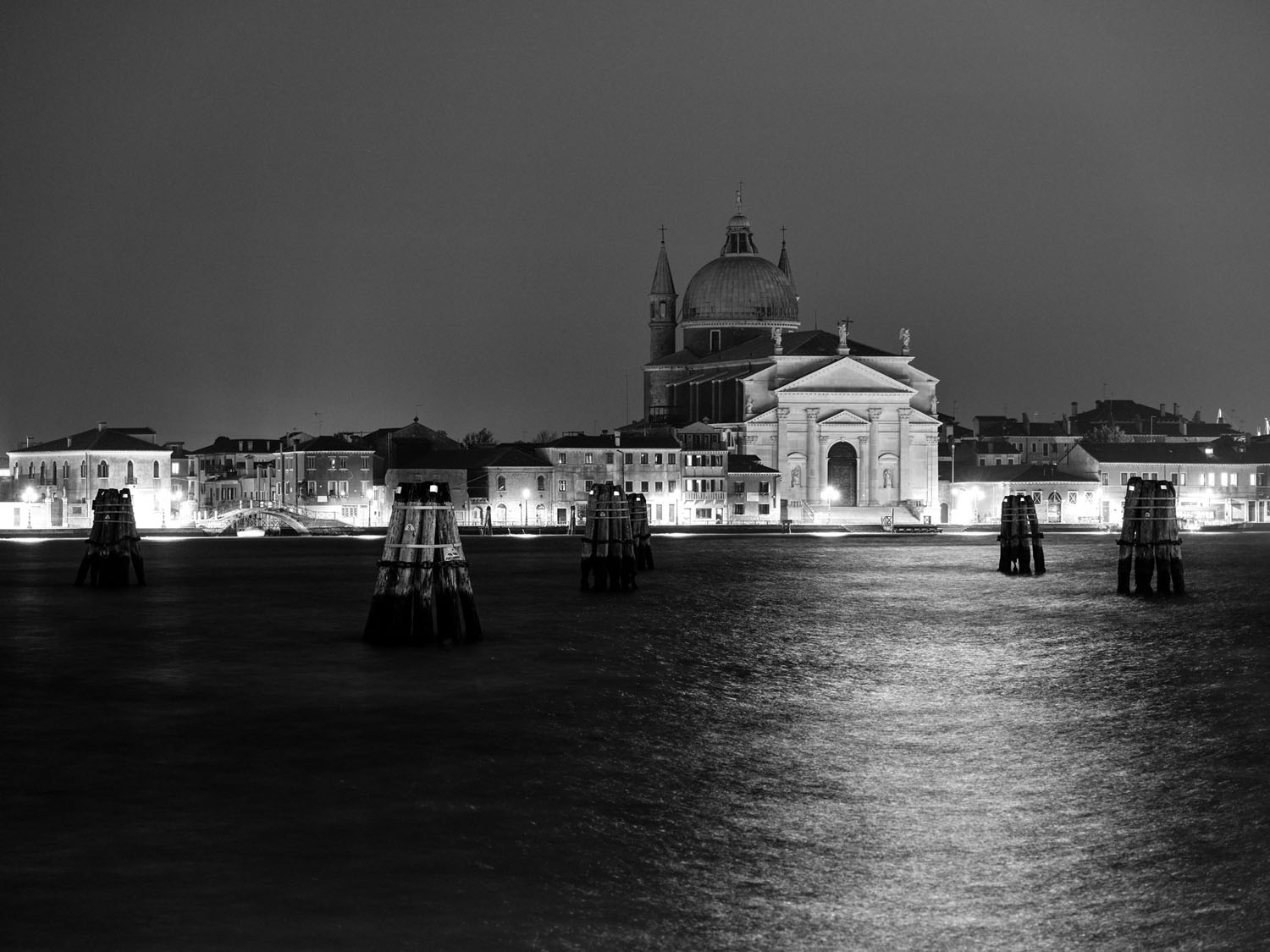
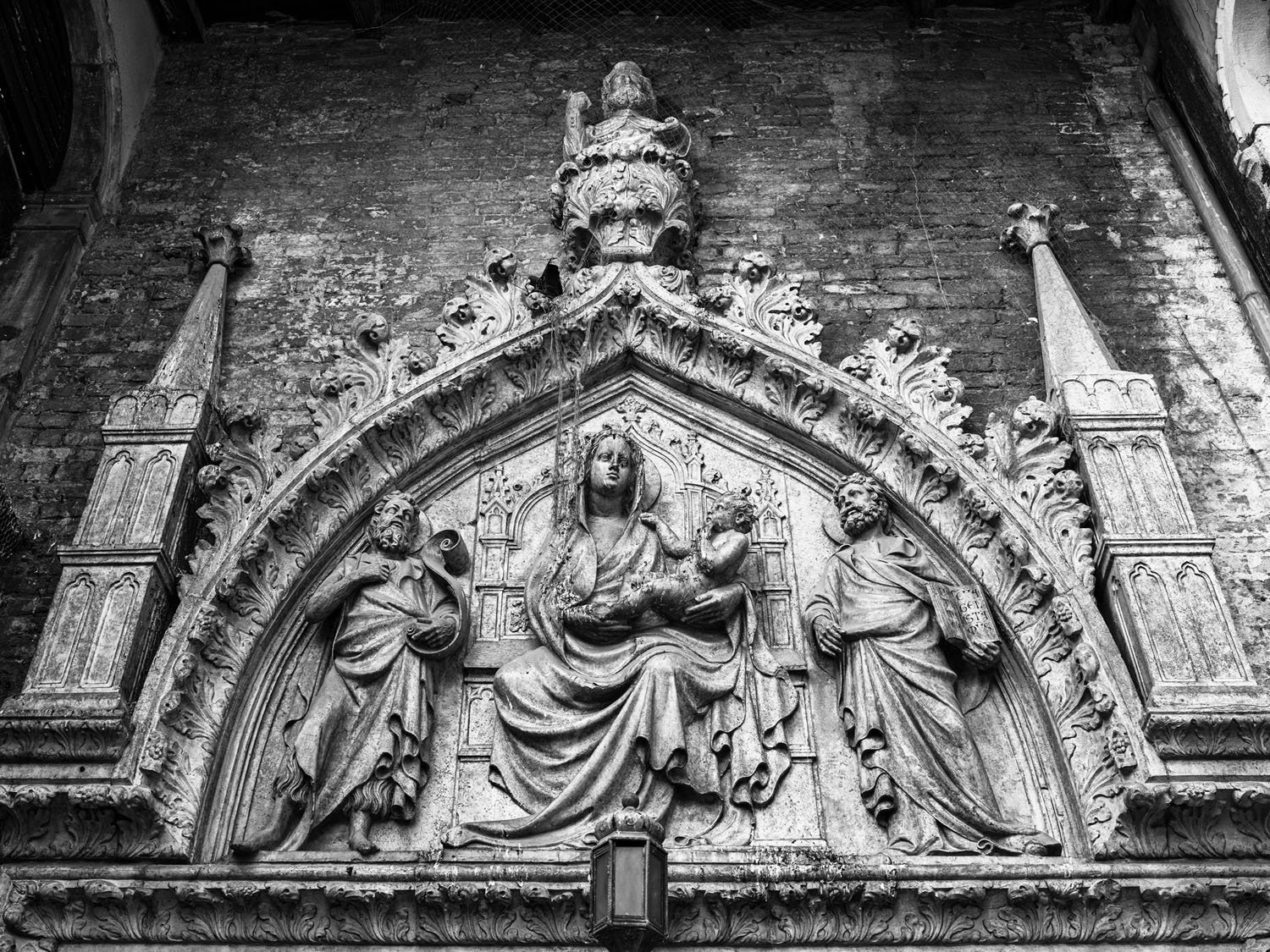
In the meantime, I have to say goodbye to the lagoon again. While I take the vaporetto in the direction of Piazzale Roma, I remember the words of Claude Monet: “One cannot leave Venice without wanting to return.” How right he was to be…
P.S.: Could I resist the temptation to photograph or develop in color? Of course not! There are moods, I had to admit to myself in the course of my attempt, in which not only the classics or hot spots of Venice simply look impressive in color….
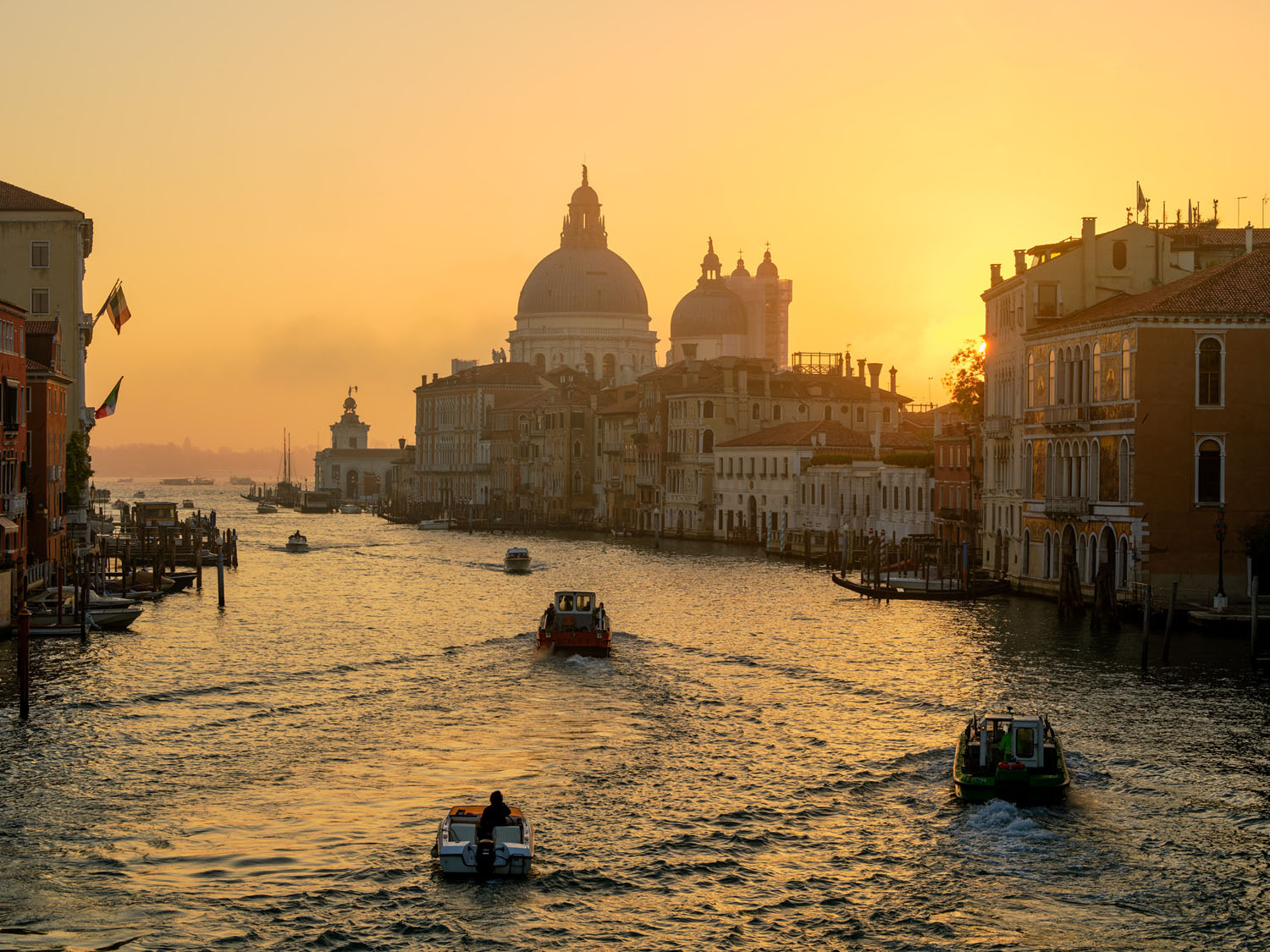
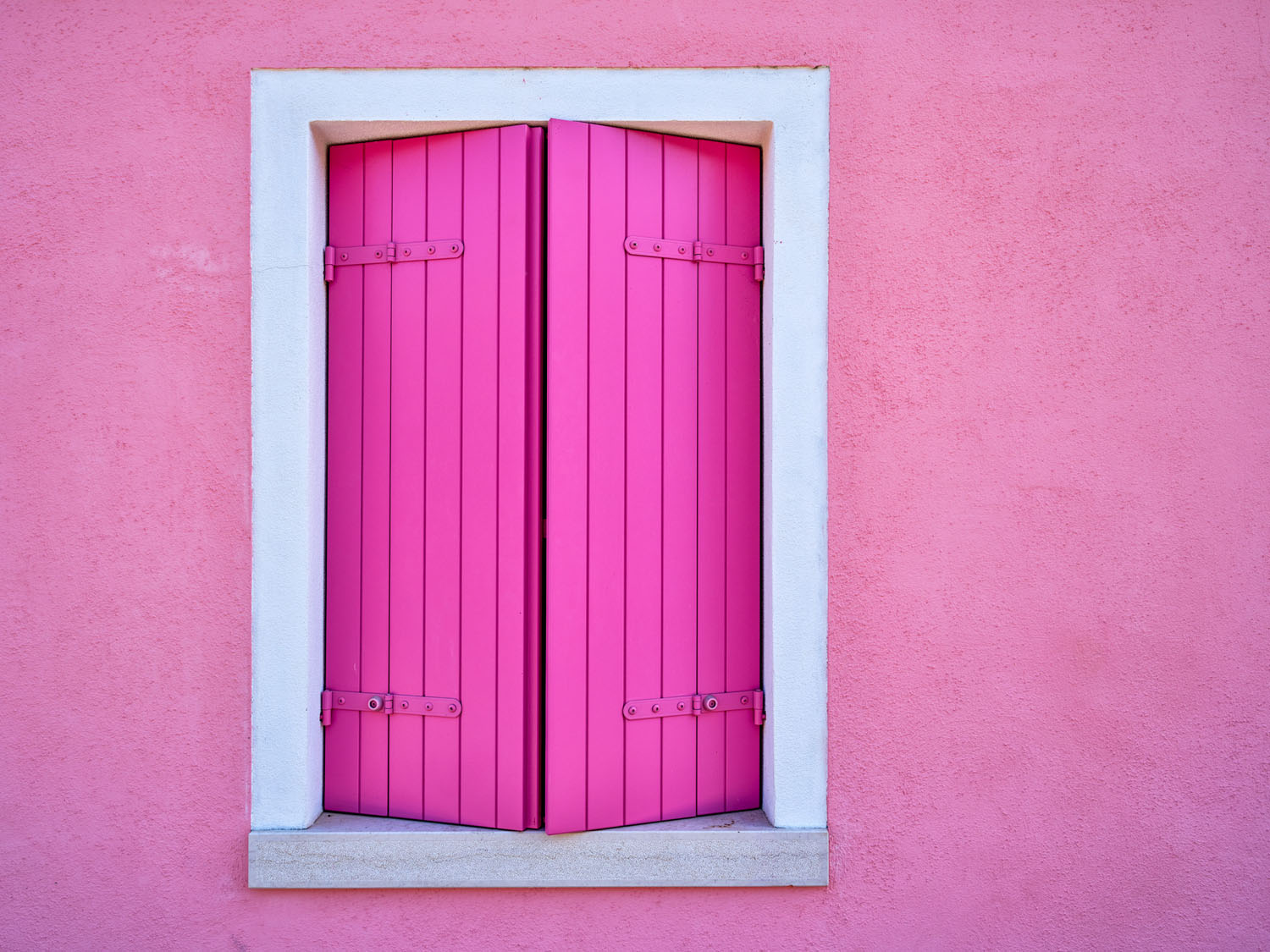
RIGHT: Fuji GFX 100 . Fuji GF32-64mmF4 @34mm . f/13 . 1/125″ . ISO 125 . WB 4.850K – In the colorful alleys of Burano | Burano
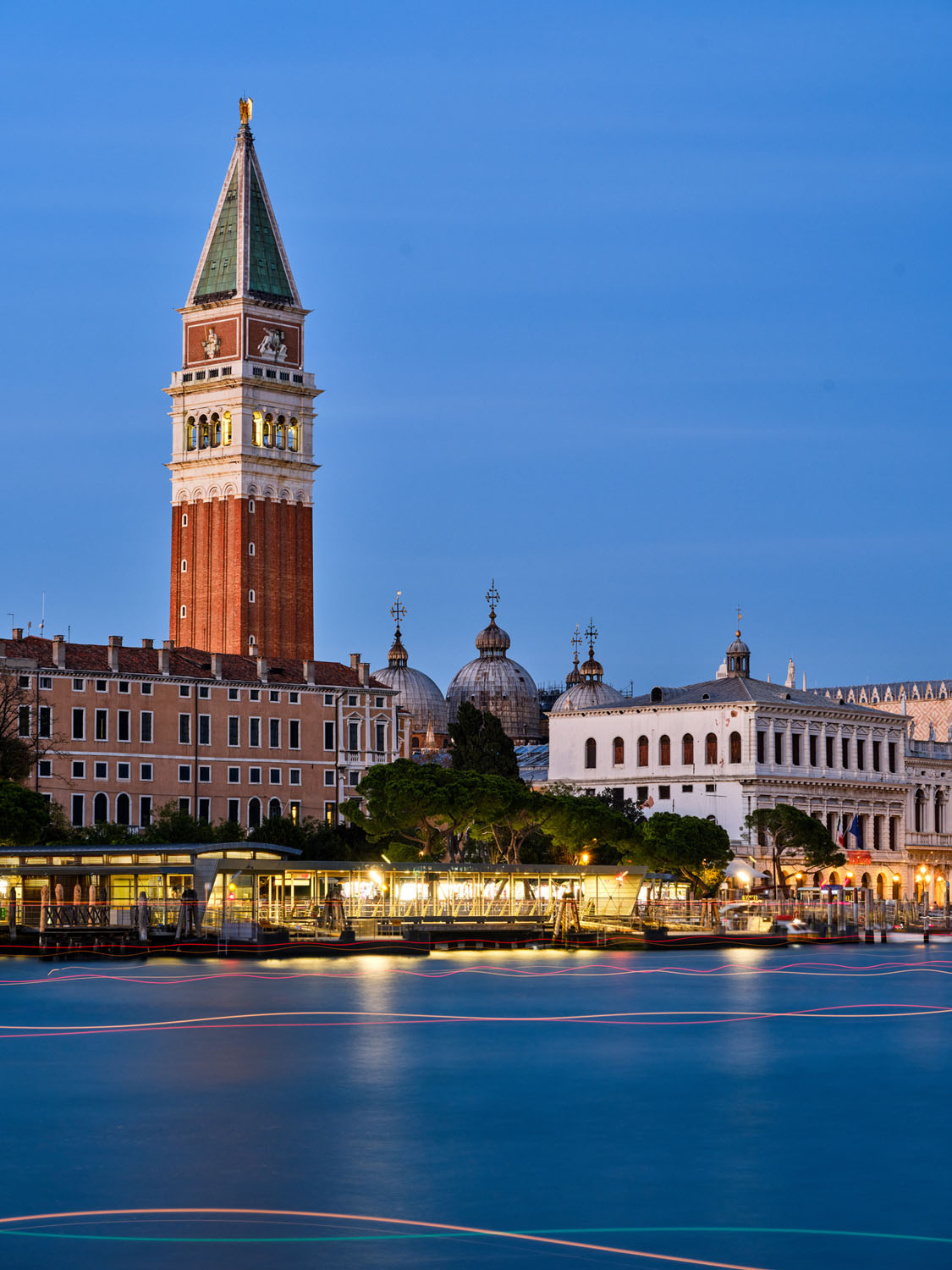
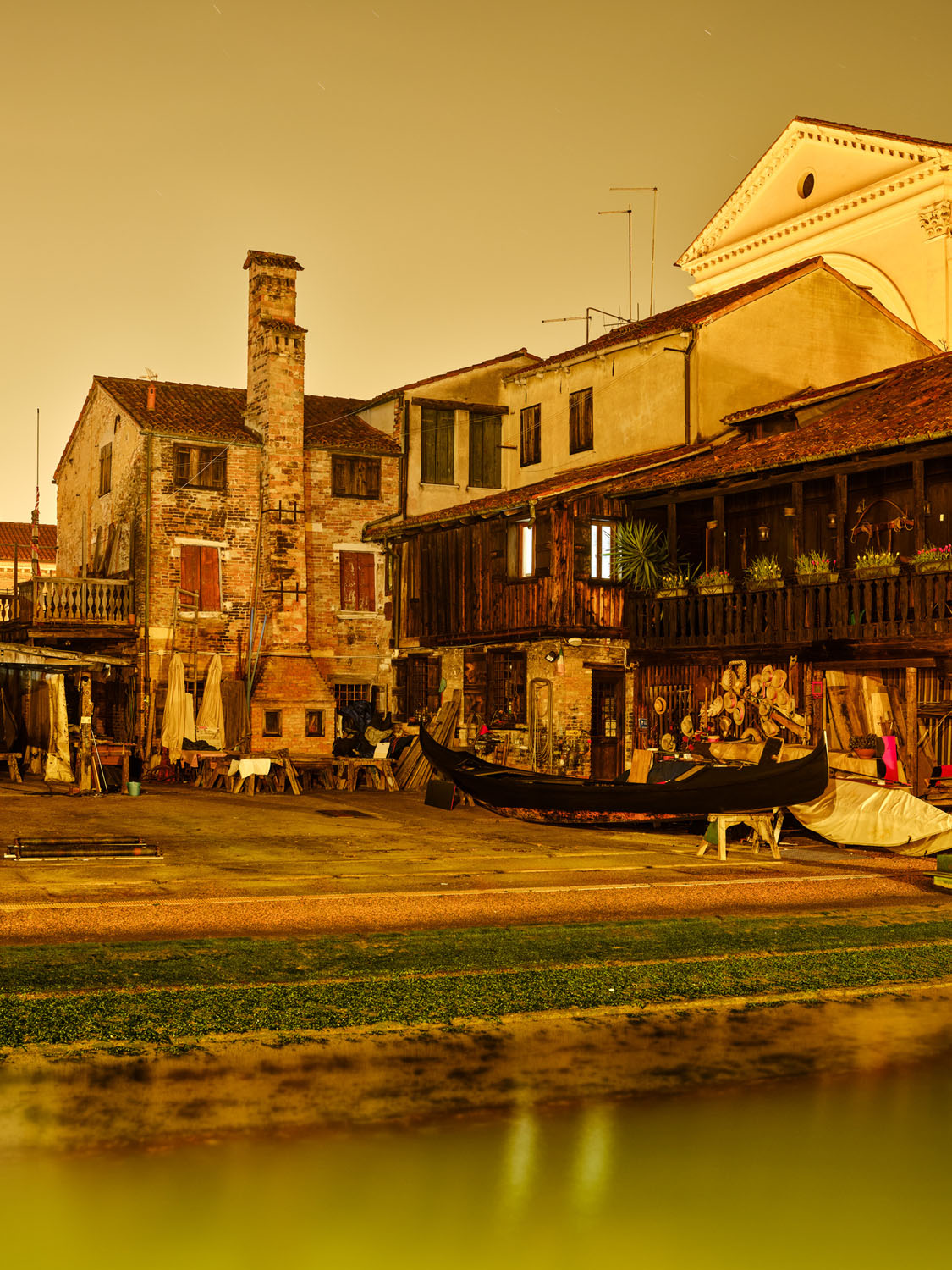
RIGHT: Fuji GFX 100 . Fuji GF45-100mmF4 @55mm . f/7.1 . 160″ . ISO 640 . WB 4.900K . Tripod – Rio San Trovaso with the historic looking gondola wharf | Dorsoduro
Info box…
A deserted Venice is probably as unrealistic as a deserted city in the Asian environment. A good time to travel, with moderate tourism offers the late autumn as well as January. For those hoping for aqua alta, the days around full and new moon between late September and mid-March offer a good opportunity. Foggy days are offered between the end of October and the end of January. Nevertheless, they are a lucky time.
Depending on the duration of the trip, the ACTV ticket is worthwhile for comfortable travel by vaporetto through the lagoon city.
For a smooth power supply, I use a travel plug from SKROSS (Pro travel plug).
Inexpensive restaurants are known to be found away from the main tourist attractions. Espresso and cappuccino prices are reduced if they are drunk standing at the bar instead of sitting at the table.
For those interested in more B&W in Venice, here’s a small selection….
- Venice in Solitude, Christopher Thomas, ISBN: 978-3791346427 [English]
- Stilles Venedig, Peter Knaup, ISBN: 978-3862280049 [German]
(https://youtu.be/CAWx_MmP5EI) - Venedig, Günter Derleth, ISBN 9783982115511
- Hypervenezia, Mario Peliti, ISBN: 978-8829711697 [Italian / English]
(https://youtu.be/DF5nt8v_OTY) - Dream of Venice in Black and White, Tiziano Scarpa, ISBN 978-0990772521 [English]
For those who are enthusiastic about historical recordings, these titles are recommended…
- Venedig in frühen Photographien, Dietmar Siegert, ISBN: 978-3923979066 [German]
- Carlo Naya – Venedig in frühen Fotografien, Katalog Kupferstichkabinett Wien, ISBN: 9783901031274 [German]
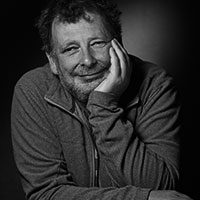
His attention is focused on the landscape in its many manifestations. His focus is on the photographic realization of landscapes as they are formed by nature and shaped by human use and culture. He regularly passes on his knowledge to interested parties in workshops and on photo trips/excursions.




Mark Callan
August 25, 2023 @ 1:03 pm
Knocked out by these lovely, lovely pictures! I was in Venice earlier this year and I wish I’d managed anywhere near as well as you have. Thanks for sharing – the tips as well as the pictures.